Take Trips, Make Memories


Arashiyama Self-Guided Walking Tour & Things to Do
Located on the western side of Kyoto, Arashiyama is a fascinating blend of nature’s beauty and historical heritage. The well-known places in this area are usually filled with tourists. However, taking a few steps off the busy streets, you’ll find much less crowded spots that are just as beautiful. With this in mind, we’ve put together an Arashiyama self-guided walking tour that will take you through both the popular and the less visited parts. It was the route we actually took in our trip and thoroughly enjoyed.
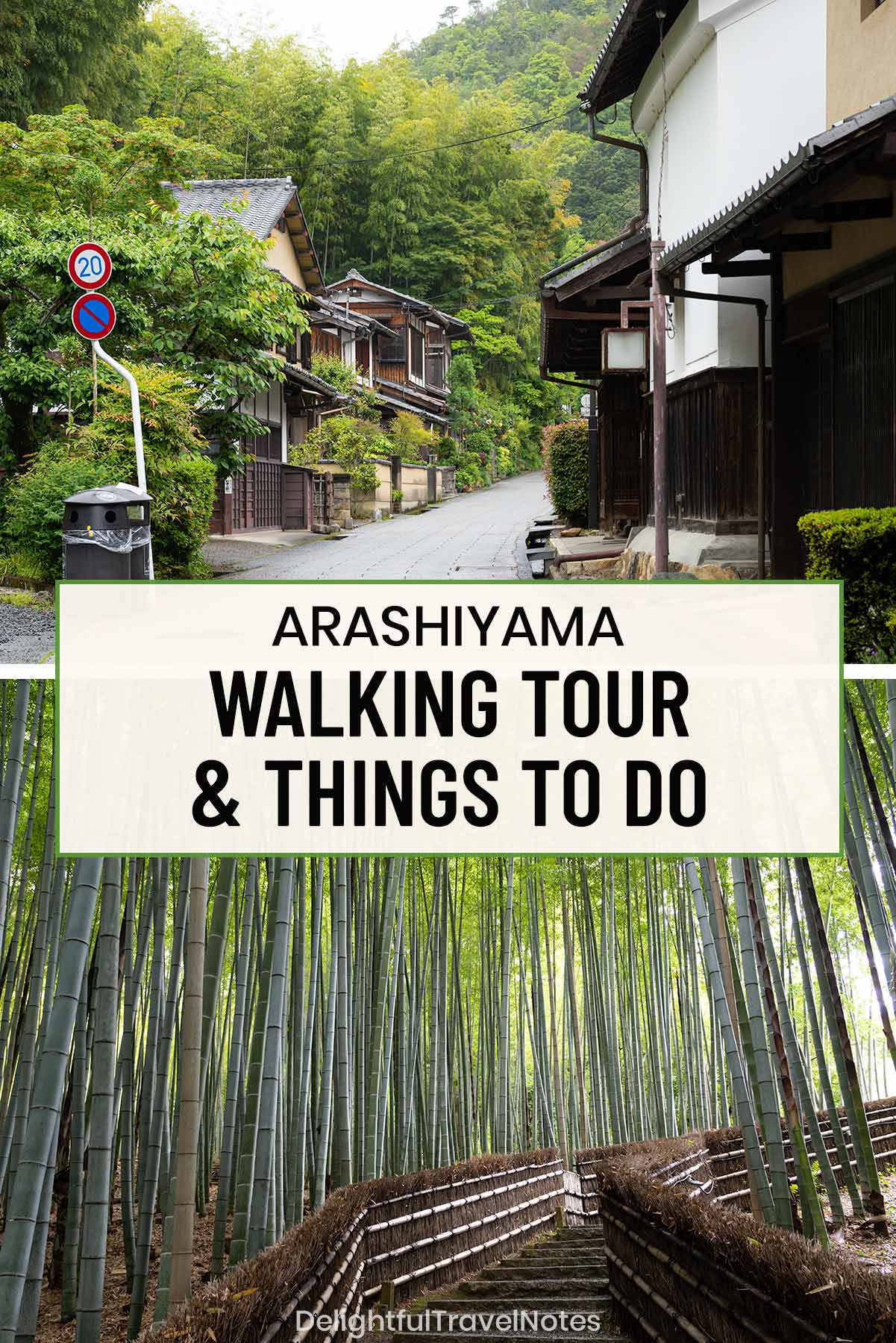
We initially planned to leave Arashiyama out of our four-day itinerary in Kyoto since it was quite far from our accommodation at the Celestine Gion hotel , and it looked like the main draw of the area was the bamboo forest which was always crowded. After doing more research, we realized there was much more to see in Arashiyama than the bamboo forest. So we came up with this walking route to explore the area while avoiding the crowds (to some extent).
In Arashiyama, popular places such as the bamboo forest and Tenryu-ji temple are always packed with people. In contrast, just a short walk from these busy spots, there are quiet corners where it feels like you have the whole place to yourself.
Suggested Route
First, we want to share the walking route we did ourselves, and then we will make some recommendations for alternative routes with a different starting point. Feel free to modify this self-guided walking tour to suit your preferences and schedules.
Otagi Nenbutsu-ji: Starting Point
- Hours: 8 am – 4:30 pm
Begin your self-guided walking tour at the serene Otagi Nenbutsu-ji temple in the morning. The easiest and quickest way to get here is by taxi, which we did. If you rely on public transportation, I think you will need to combine a train and bus ride.
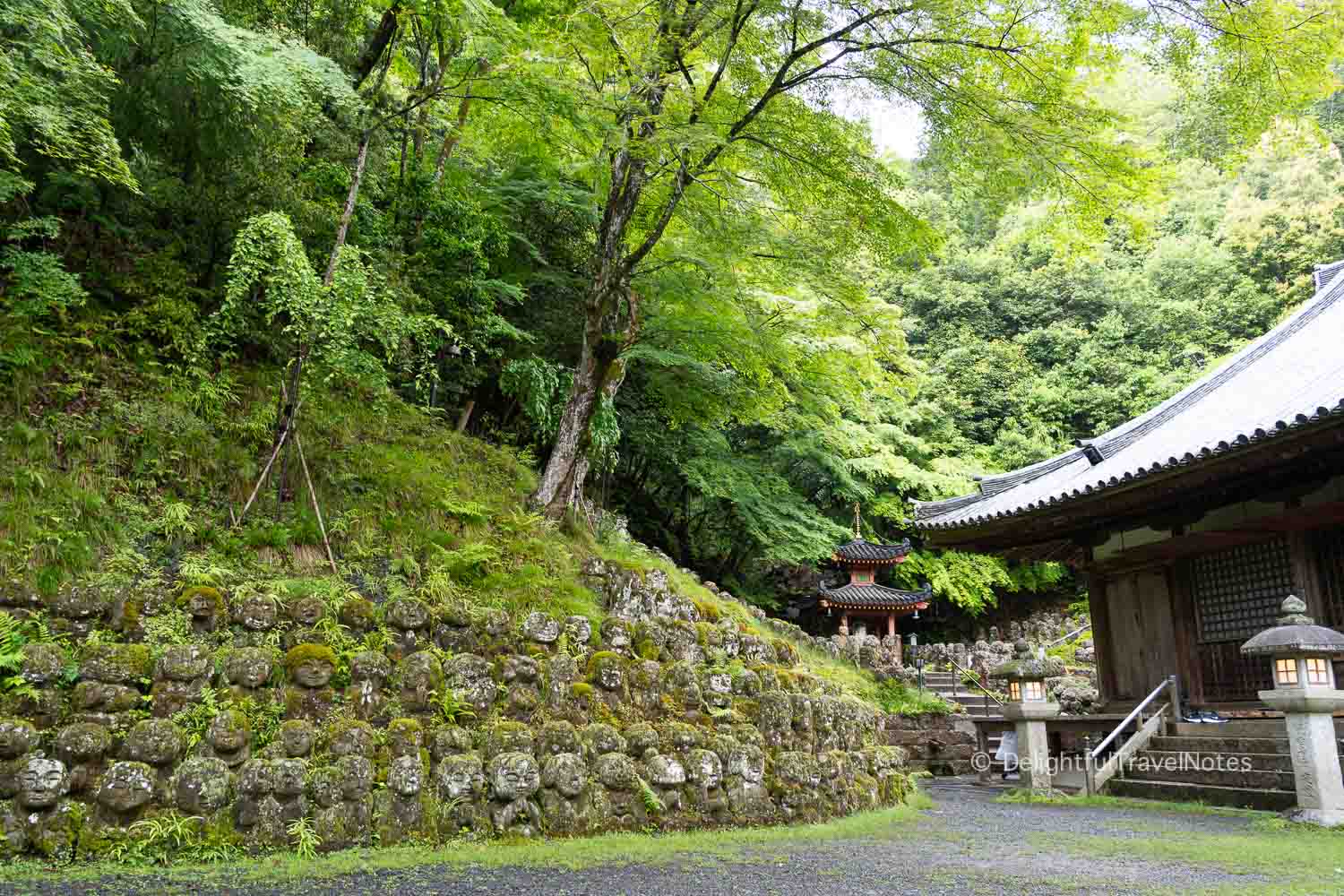
Otagi Nenbutsu-ji has been destroyed and rebuilt several times. Surrounded by the nature’s beauty with moss-covered stones and verdant forests , this place has such a serene atmosphere . We only saw 2-3 other visitors when we were there.
The temple’s highlight is the collection of about 1,200 stone statues of rakan (Buddha disciples), each with unique expressions and poses, conveying many facets of human emotions. These statues were hand-carved by amateurs and professional artists under the guidance of a head priest in the past.
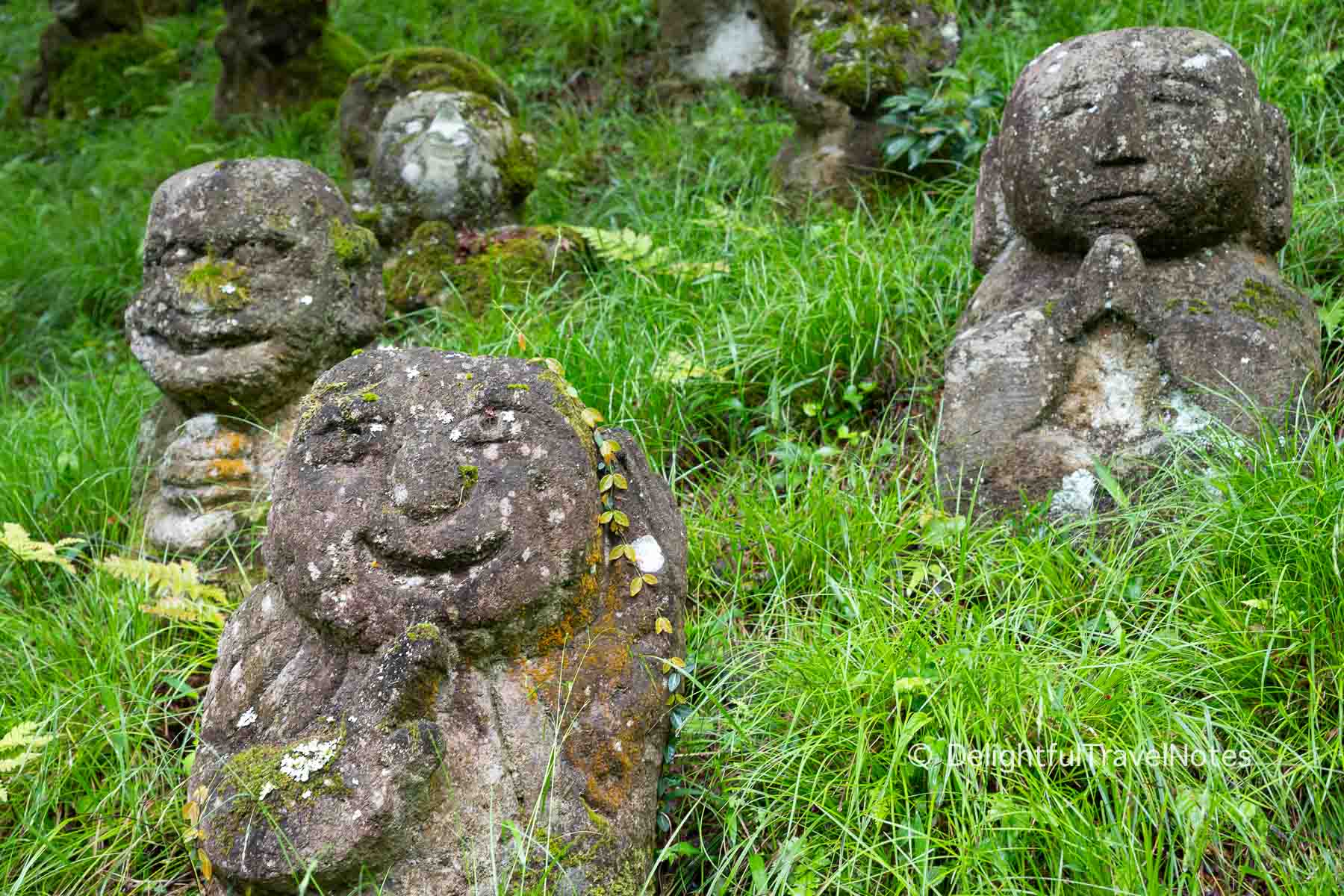
We chose Otagi Nenbutsu-ji as the starting point of our walking route also because from this point onward, the path is either downhill or flat , making the walk more enjoyable and less strenuous than an uphill one in the opposite direction.
Adashino Nenbutsu-ji
- Hours: 9 am – 4:30 pm
A short stroll downhill from Otagi Nenbutsu-ji is Adashino Nenbutsu-ji , another Buddhist temple known for its tranquil atmosphere . The temple has a rich history that dates back to the early Heian period in the 9th century. Here, you will find many stone Buddha statues serving as a memorial for the souls of the departed, giving the place a unique sense of peace.
Don’t miss the opportunity to walk through the bamboo garden at the back of the temple. Though it isn’t big, the bamboo garden is very beautiful and quiet. We enjoyed it much more than the popular Arashiyama bamboo forest.

Saga Toriimoto Preserved Street
From Adashino Nenbutsu-ji, head toward the quiet and picturesque Saga Toriimoto Preserved Street . This charming area has retained its traditional Meiji Period ambiance with well-preserved wooden townhouses (machiya).
Walking down this area feels like a journey back in time. Many of the wooden houses that line the street have been carefully preserved or restored to maintain their original appearance. As you stroll down this historic area appreciating its tranquility, you can consider visiting some temples along the way, such as Gio-ji, Nison-in and Jokakko-ji.
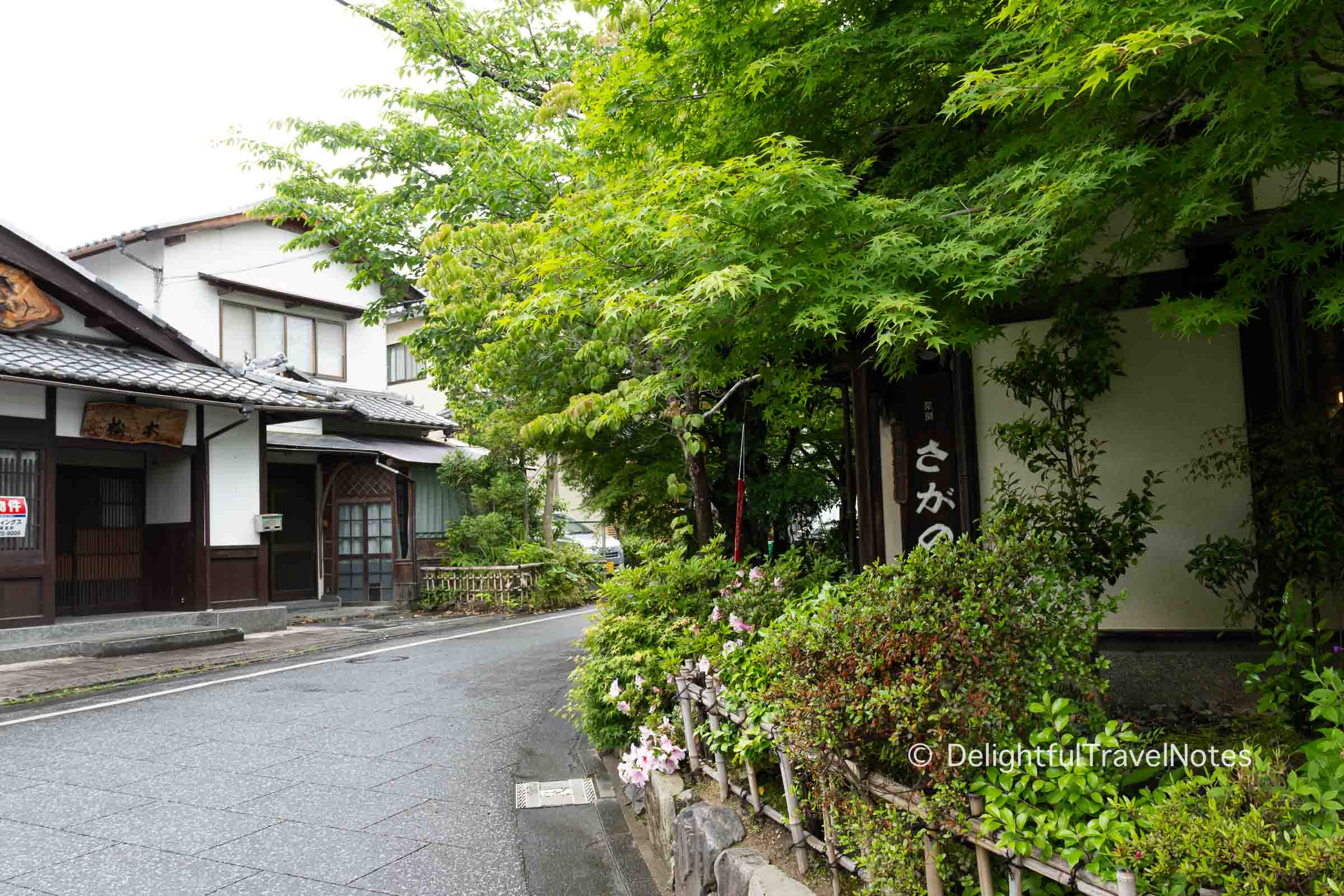
Arashiyama Bamboo Forest
- Hours: 24 hours
Continue to walk south for about 15-20 minutes toward the Arashiyama Sagano bamboo forest . The bamboo grove here is usually very crowded in the middle of the day. Despite the crowds, we quite liked listening to the rustling sound of bamboo leaves.
With that said, this bamboo forest still felt too touristy for us. The atmosphere was the opposite of what we experienced at the two Nenbutsu-ji temples. I have a write-up of lesser-known bamboo groves to visit in Kyoto as quiet alternatives to Arashiyama bamboo forest.

Once you reach the Arashiyama bamboo forest, you can choose between heading to Tenryu-ji or Okochi Sanso Garden . Of course, you can see both if your schedule allows.
Okochi Sanso Garden
- Hours: 9 am – 5 pm
Covering around 20,000 square meters, Okochi Sanso Garden includes a villa, a tea house, and several smaller buildings, all interconnected by a winding path that takes you through beautifully landscaped gardens. You will find a tranquil atmosphere at this garden, away from the crowds at the bamboo forest.

Tenryu-ji Temple
- Hours: 8:30 am – 5 pm

Tenryu-ji is a Zen Buddhist temple and a UNESCO World Heritage Site. Its name means “Temple of the Heavenly Dragon”. The temple complex houses several important cultural properties , including the main hall, the drawing hall, and the temple gate.
The garden is also a highlight at Tenryu-ji, and it is considered one of the most significant historical gardens in Japan. The surrounding landscape was incorporated into the design of the garden, creating a seamless blend of human-crafted elements and the beauty of nature. You will need to buy separate tickets for the garden and for the temple halls.
Togetsukyo Bridge
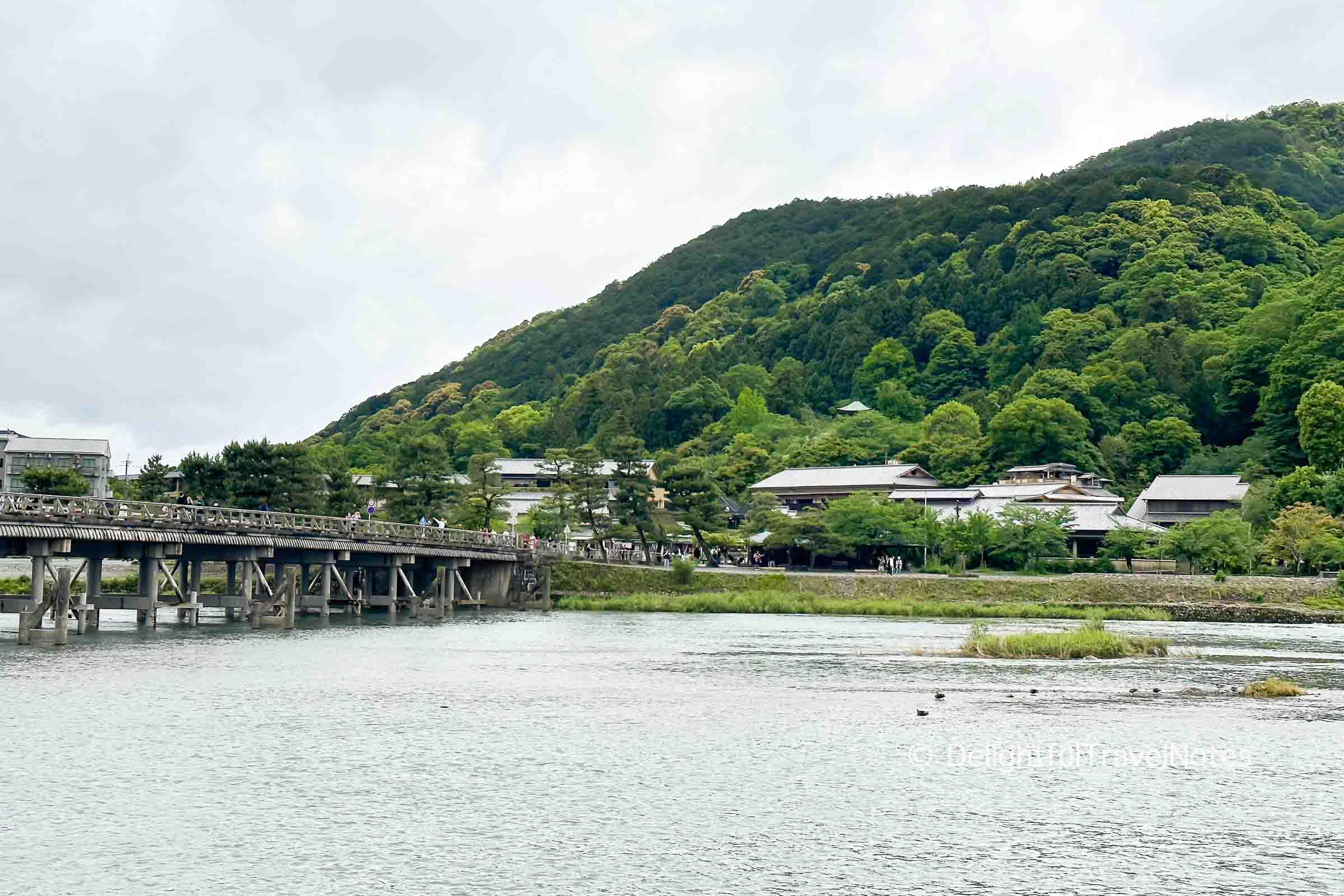
Continue the walk to Katsura River and Togetsukyo Bridge , where you will have a fantastic view of the river below and the surrounding mountains. The area can be crowded, but the scenery is incredibly picturesque . I can imagine how beautiful fall colors will be in Arashiyama.
The area surrounding the river and the bridge is bustling with a variety of shops, restaurants, and street food stalls offering local delicacies.

Arashiyama Monkey Park Iwatayama
- Hours: 9 am – 4 pm
Next, you can head to Arashiyama Monkey Park Iwatayama , home to a large troop of wild Japanese macaque monkeys. Visiting this park is one of the most popular things to do in Arashiyama. Here, you can enjoy panoramic views of Kyoto while feeding the monkeys under the staff’s guidance.
We didn’t go to this park since we had little interest in seeing monkeys. We saw some reviews that said the hike to the park was quite steep and rough.
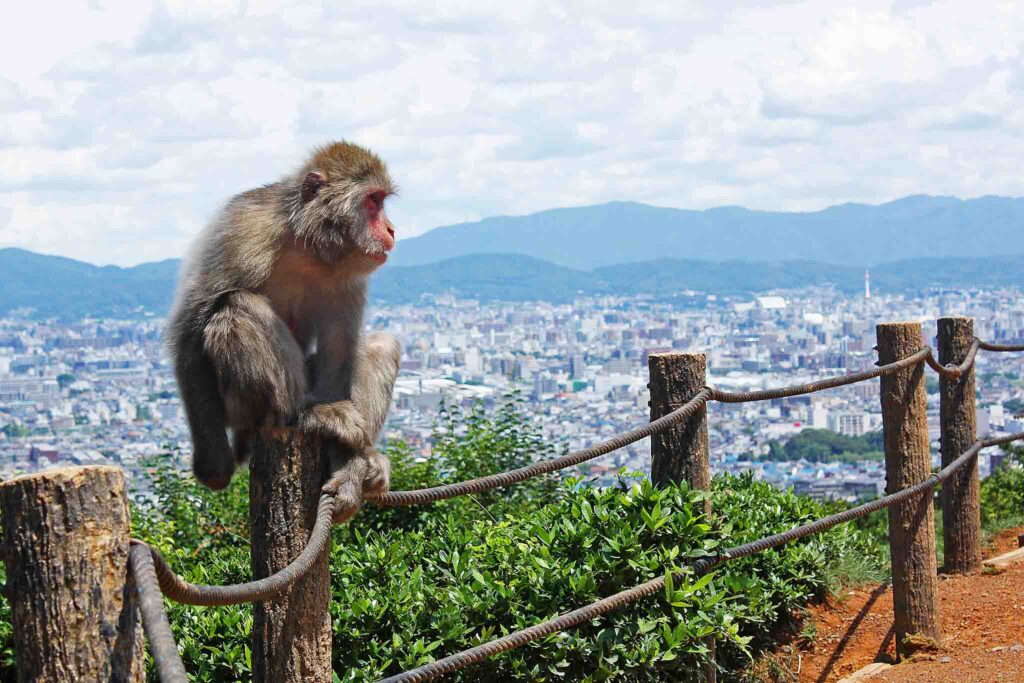
Alternative Route
The disadvantage of the walking route we took and suggested above is that you will arrive at Arashiyama bamboo forest and Tenryu-ji in the middle of the day. Both places will be packed with people by that time, affecting the experience. So, if you don’t mind waking up early, here’s an alternative route you can consider:
- Arrive at Arashiyama bamboo forest early in the morning and walk through it. Then visit Tenryu-ji right around its opening time.
- Take a taxi or bus to Otagi Nenbutsu-ji, and stroll down from there through Adashino Nenbutsu-ji and Saga Toriimoto Preserved Street. Then you can continue to visit Okochi Sanso Garden and the Monkey Park.

Instead of walking and exploring on your own, you can consider an Arashiyama guided walking tour to learn interesting facts and stories from a local guide. If the walk seems too long for you, it is possible to combine it with an Arashiyama rickshaw tour or bike tour . We saw quite a few tourists on the rickshaws.
Arashiyama Must-try Restaurants
If you visit all the places and do everything mentioned above, you will likely spend a whole day in Arashiyama. Take time to enjoy lunch in the area, giving your legs a break while savoring some excellent food. Here are some of the must-try restaurants in Arashiyama.

Tofu restaurants
Tofu is one of Kyoto specialty foods you must try. Below are several excellent tofu restaurants in Arashiyama. They all serve delicious multi-course meals that showcase tofu in various delectable forms.
- Shoraian : reservation is strongly recommended
- Yudofu Sagano
- Tofu Matsugae

Tenryu-ji Temple Shigetsu
Shigetsu , located within the Tenryu-ji temple complex, serves shojin ryori, a traditional Buddhist vegetarian cuisine. The set meal consists of seasonal vegetables prepared in various ways.
Unagi Hirokawa
Kansai-style grilled eel is also one of Kyoto must-eats . Unagi Hirokawa specializes in grilled eel served over rice. Their unagi is tender, flavorful, and grilled to perfection. Note that it’s extremely popular, so many people line up before it opens.
Arashiyama Yoshimura
Located near Togetsukyo Bridge, Arashiyama branch of Yoshimura offers soba noodles with a view. Yoshimura’s handmade soba noodles can be enjoyed hot or cold. There may be a long wait around peak lunch time.

Arashiyama has much more to offer beyond the famous bamboo grove that it is so often recognized for, and we were glad we didn’t leave it out on our first visit to Kyoto. This fascinating area of Kyoto blends nature, culture, and history in a way that invites exploration and appreciation.
We hope you will find our suggested self-guided walking tours and things to do in Arashiyama useful. Please feel free to modify the walking routes as you see fit to create your own unique Arashiyama experience.
More Kyoto Travel Guides

Trip Report: Amazing Four Days in Kyoto

Explore Kyoto Cuisine: Top Local Foods and Restaurants to Try

Review: The Celestine Hotel Gion Kyoto
Similar posts.

Breakfast in Japan: What & Where to Eat
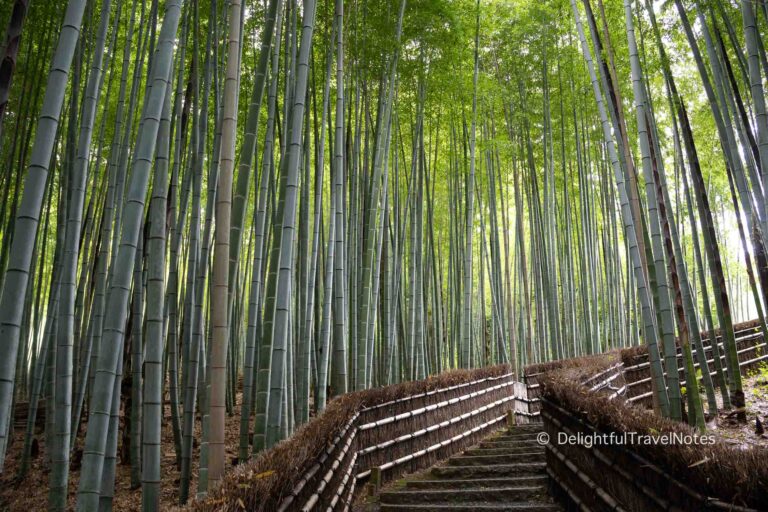
Bamboo Groves to Visit in Kyoto (and Alternatives to Arashiyama Bamboo Forest)
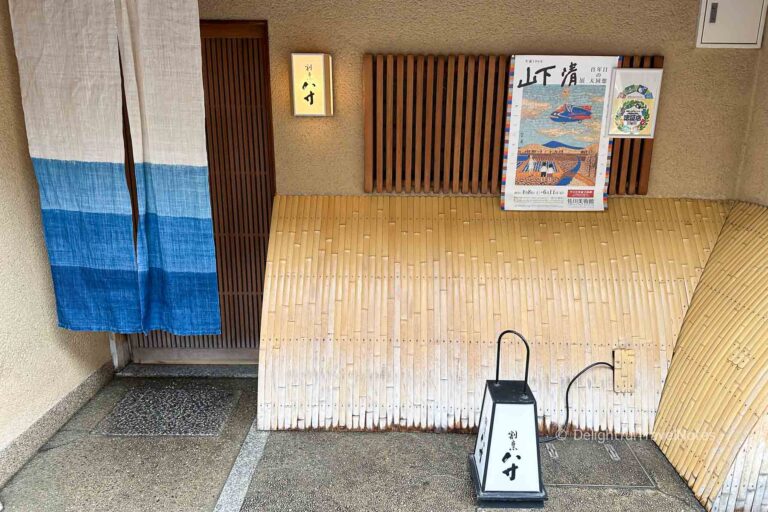
Review: Hassun Restaurant in Kyoto
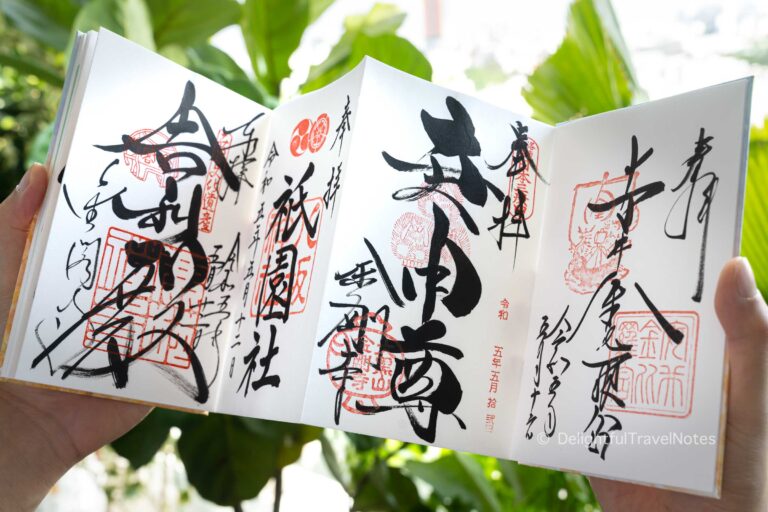
Goshuin Guide: What Is It & How to Collect
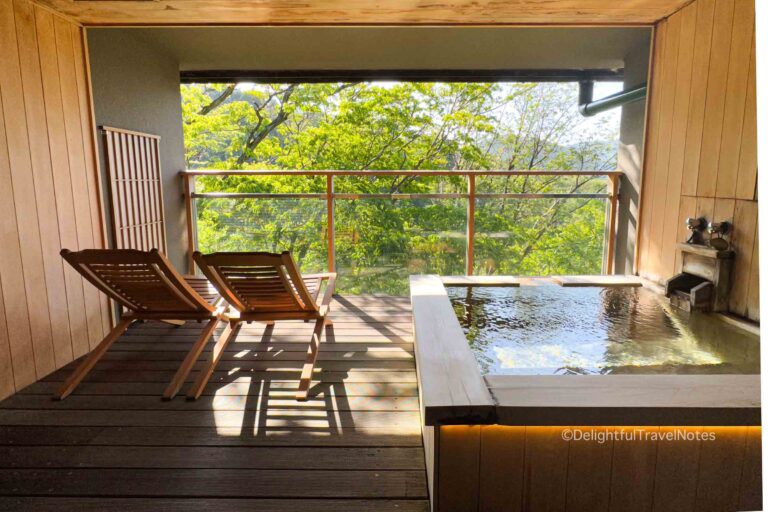
Review: Madoka no Mori Ryokan in Hakone
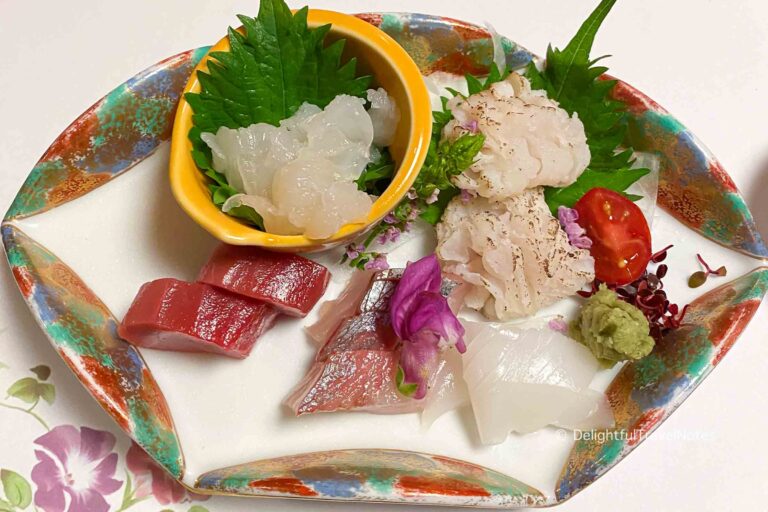
Hanasaki Manjiro Restaurant Review – Affordable Kaiseki in Kyoto
Leave a reply cancel reply.
Your email address will not be published. Required fields are marked *
Save my name, email, and website in this browser for the next time I comment.
Notify me of followup comments via e-mail. You can also subscribe without commenting.

Kyoto: 4-Hour Arashiyama Walking Tour
- Kyoto , Tour Reviews , Walking Tours
In the picturesque city of Kyoto, the ‘Kyoto: 4-Hour Arashiyama Walking Tour’ offers a captivating juxtaposition of hidden gems and popular attractions.
Led by a knowledgeable local guide fluent in English and Japanese, this immersive experience takes visitors off the beaten path to discover the lesser-known side of Arashiyama.
Starting at the JR Saga-Arashiyama station North Exit, you will bypass the crowded route to the bamboo forest and instead explore the charming Saga-Toriimoto area, where local gift shops, temples , and shrines await.
Along the way, the guide will share fascinating local stories and legends, adding depth to the journey.
From the UNESCO World Heritage Site, Tenryu-Ji temple, to an authentic Kyoto-style lunch with a view of the iconic Togetsukyo bridge, this tour promises a deeper understanding of Kyoto’s culture, history , and natural beauty.
Quick Takeaways
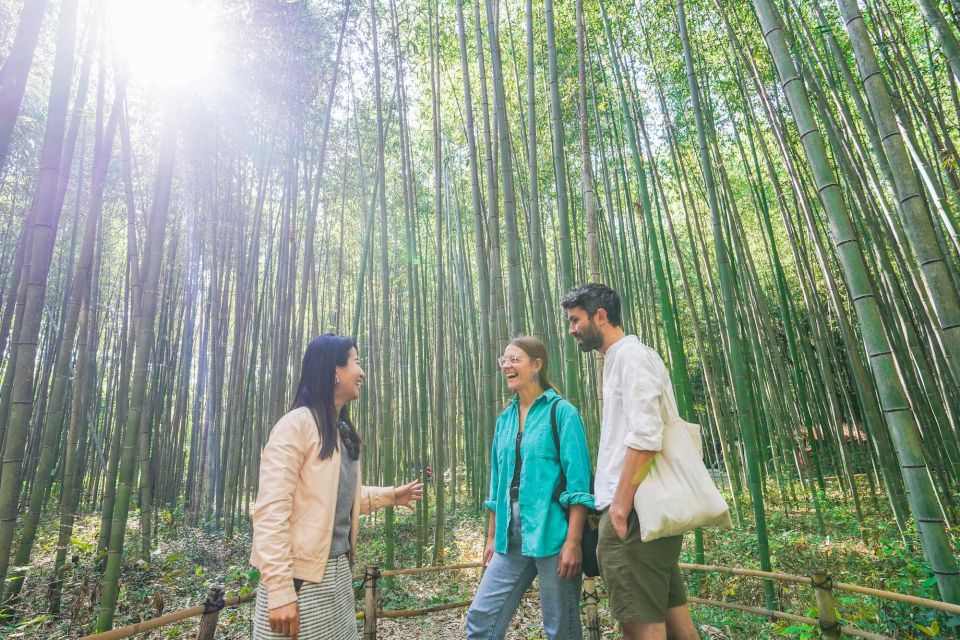
- The Arashiyama walking tour in Kyoto offers a unique and lesser-known experience of the area.
- The tour includes a visit to the UNESCO World Heritage Site, Tenryu-Ji temple, known for its beautiful garden and serene atmosphere.
- Participants can enjoy an authentic Kyoto-style lunch with a special view of the Togetsukyo bridge, a famous landmark in Arashiyama.
- The tour provides an opportunity to explore the local gift shops, temples , and shrines , and learn about the local stories and legends from a knowledgeable guide.
Not for you? Here's a few more great tours and experiences nearby.
Private Airport Transfer Kansai Airport in Kyoto Using Hiace
- Samurai Experience & Kenbu Show in Kyoto
- Perfect 4 Day Sightseeing in Japan
- Osaka Kansai Airport (KIX) to Kyoto – Arrival Private Transfer
Booking Details
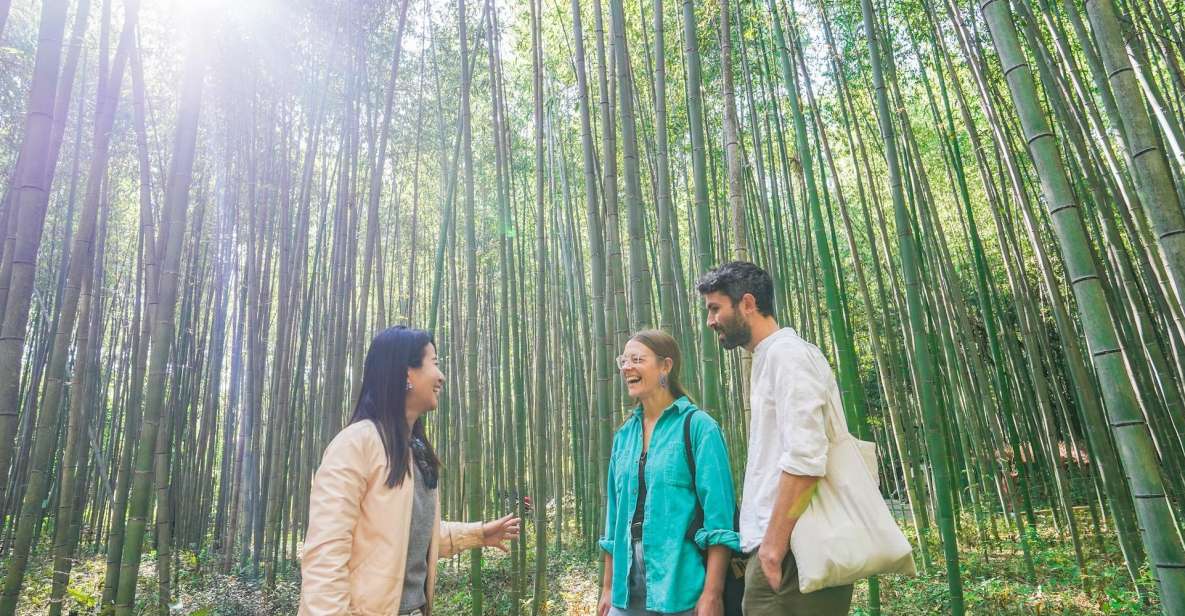
To book the Kyoto: 4-Hour Arashiyama Walking Tour, travelers can reserve their spot without payment today. The booking process is designed to be hassle-free and convenient.
Once you have checked the availability for starting times, simply select the desired date and time slot for your tour. The payment options are flexible, allowing you to pay later. This ensures that you can keep your travel plans flexible and make any necessary changes without losing your spot.
Plus, free cancellation is available if you need to cancel up to 24 hours in advance. The tour is limited to a small group of 7 participants, ensuring a personalized experience.
With a live tour guide who can speak English and Japanese, you can fully learn about the local culture and learn about the fascinating stories and legends of the area.
Experience Highlights
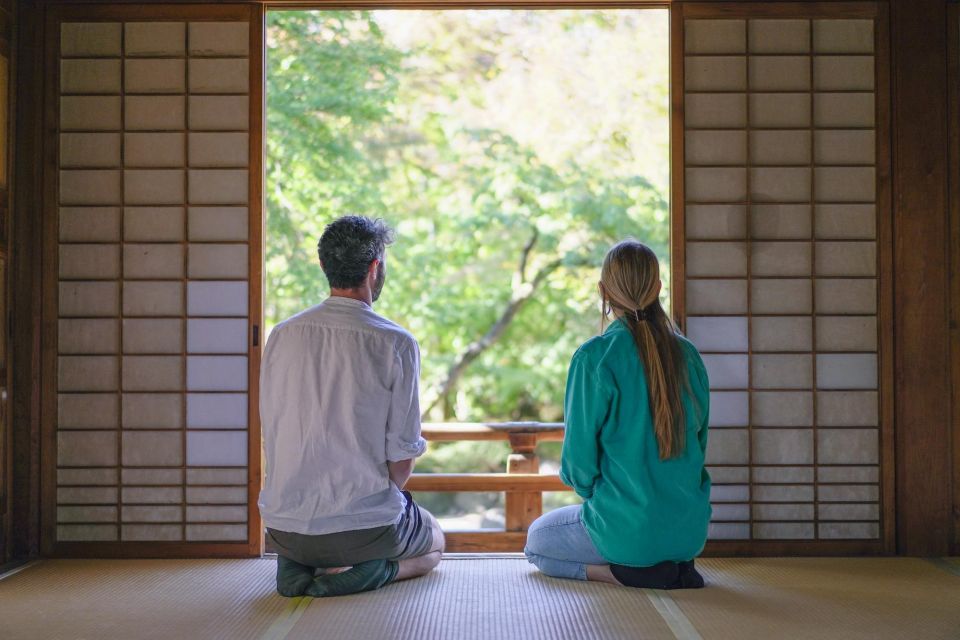
Explore a lesser-known side of Arashiyama with a local guide and discover the hidden gems that make this walking tour a unique and immersive experience.
During the tour, you will have the opportunity to visit Tenryu-Ji temple, a UNESCO World Heritage Site famous for its stunning Sogenchi pond and garden. The temple offers a peaceful and serene atmosphere, providing a glimpse into the local aristocratic lifestyle.
Another highlight of the tour is the Togetsukyo Bridge, an iconic landmark in Arashiyama that offers breathtaking views of the surrounding area. The bridge is a popular spot for sightseeing and photography, and it can be seen from the restaurant where the traditional Kyoto-style lunch is served.
By exploring the lesser-known Saga-Toriimoto area, visiting local gift shops, temples, and shrines, and learning about the local stories and legends from the guide, participants can truly enjoy the cultural richness of Arashiyama.
This walking tour provides a unique opportunity to experience the beauty of the bamboo forest and taste the local flavors and specialties, enhancing the overall culture .
Tenryu-Ji Temple
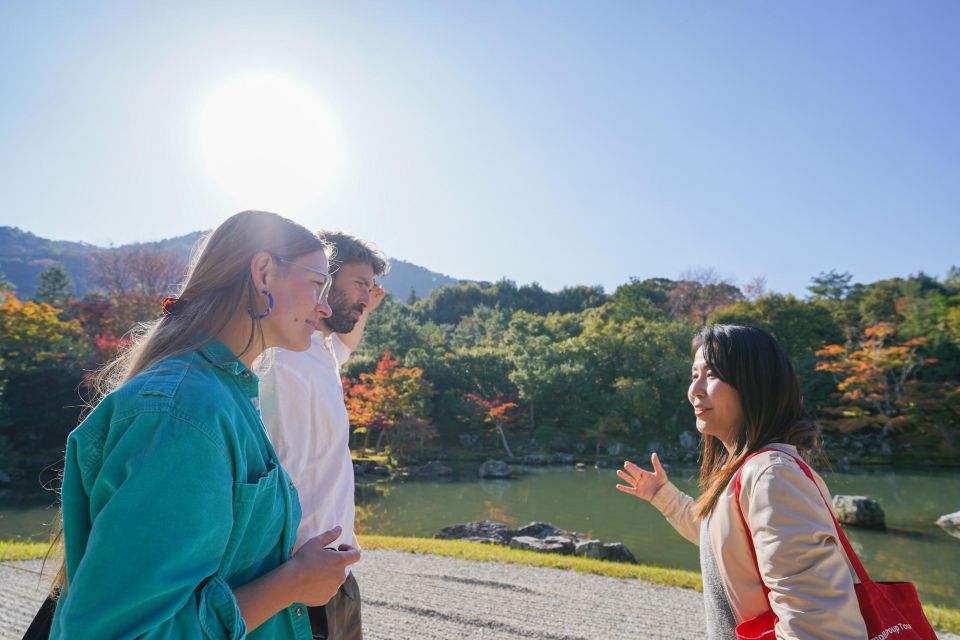
The tour continues with a visit to Tenryu-Ji Temple, where participants can explore the UNESCO World Heritage Site and marvel at its stunning Sogenchi pond and garden.
Tenryu-Ji Temple is located in Arashiyama, a popular destination for Kyoto sightseeing . The temple is famous for its beautiful garden, which was once owned by local aristocrats. The garden features the serene Sogenchi pond, surrounded by meticulously landscaped trees and plants.
Visitors can take a leisurely stroll around the pond, enjoying the peaceful atmosphere and taking in the breathtaking views. The temple itself is also worth exploring, with its traditional architecture and intricate details.
Tenryu-Ji Temple offers a glimpse into the rich history and culture of Kyoto, making it a must-visit for anyone interested in the city’s heritage.
Togetsukyo Bridge
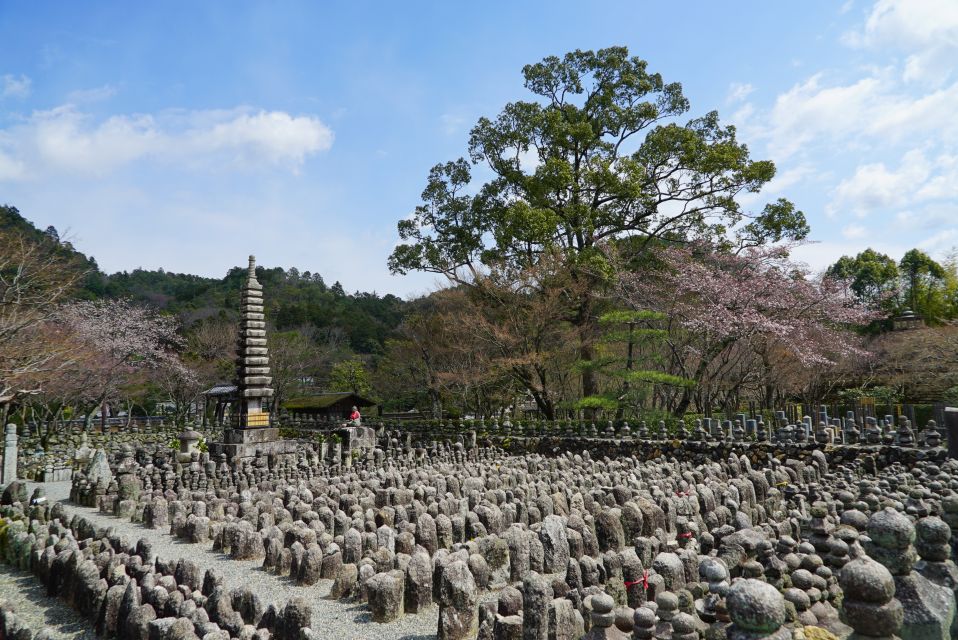
Participants on the Kyoto: 4-Hour Arashiyama Walking Tour will have the opportunity to visit the iconic Togetsukyo Bridge, which offers stunning views of the surrounding area. This historic bridge is a popular spot for sightseeing and photography, attracting visitors from all over the world.
Here are some reasons why the Togetsukyo Bridge is a must-see on the tour:
- Scenic views: The bridge provides a picturesque vantage point to admire the natural beauty of Arashiyama. From here, visitors can enjoy panoramic views of the Hozu River, the lush mountains , and the charming town.
- Photography spots : The Togetsukyo Bridge offers various photo opportunities. Capture the reflection of the bridge in the calm waters of the river or take a shot of the bridge framed by the vibrant autumn foliage during the fall season.
- Iconic landmark: As one of the most recognizable landmarks in Arashiyama, the Togetsukyo Bridge holds historical and cultural significance . It has been a symbol of the area for centuries and continues to be an important part of the local identity.
- Nearby attractions: Located near Tenryu-Ji Temple, the bridge is conveniently situated for visitors to explore the temple grounds and its beautiful garden. After crossing the bridge, participants can also enjoy a traditional lunch with a special view of the Togetsukyo Bridge, enhancing their overall experience of the tour.
Lunch Experience
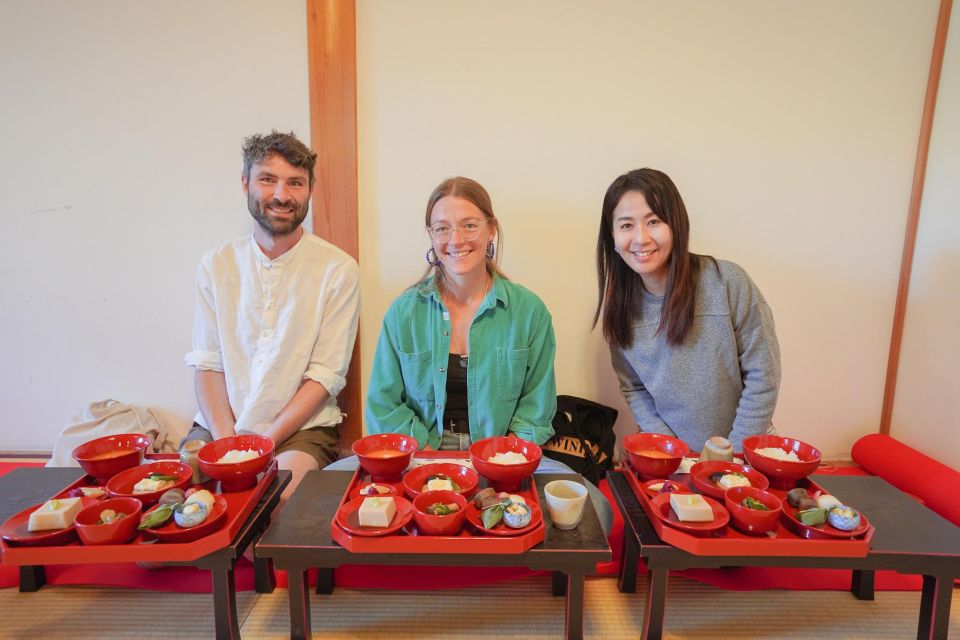
During the Kyoto: 4-Hour Arashiyama Walking Tour, you will have the opportunity to indulge in a traditional lunch with typical Kyoto cuisine. This lunch experience adds to the overall exploration of Arashiyama by providing a unique dining experience that showcases the local flavors and specialties.
Served in a restaurant with views over the Togetsukyo bridge, the lunch not only satisfies the taste buds but also offers a picturesque setting for participants to enjoy their meal. The traditional cuisine reflects the rich culinary heritage of Kyoto, known for its delicate and refined flavors. Participants can expect to taste dishes that highlight local ingredients and cooking techniques, providing a true taste of Kyoto’s gastronomy.
This lunch experience is a must-try for those looking to enjoy the local culture and culinary traditions of Kyoto.
Directions to Start the Tour
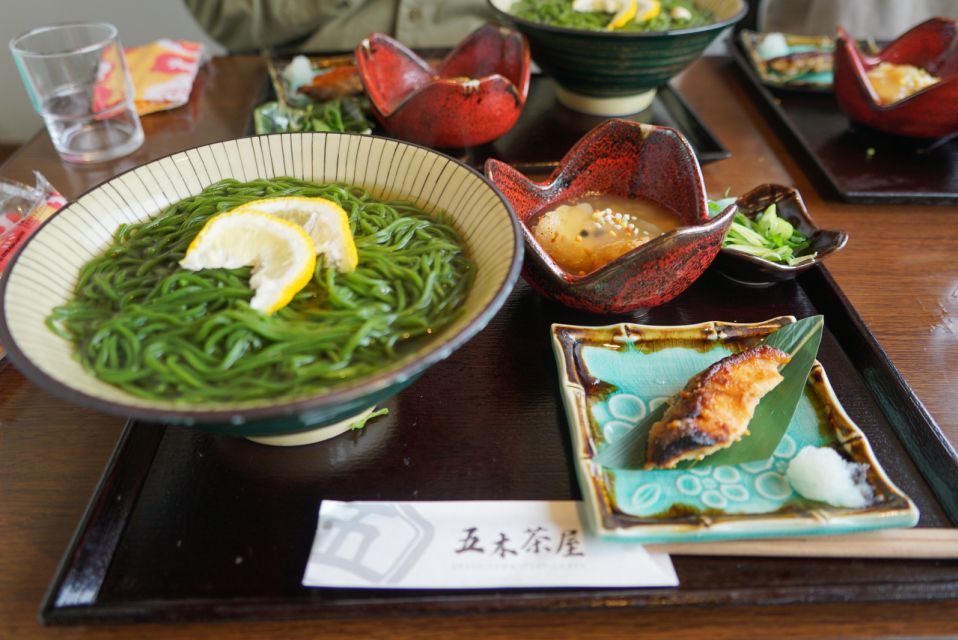
To start the tour, you will need to make their way to the JR Saga-Arashiyama station North Exit. From there, they can easily reach the meeting point by following these directions:
- Exit the JR Saga-Arashiyama station through the North Exit.
- Walk straight ahead towards the main road.
- Cross the road and continue walking straight.
- Look for the designated meeting point, which will be clearly marked.
For those using public transportation, the JR Saga-Arashiyama station is easily accessible. Participants can take advantage of the various public transportation options available, such as trains and buses, to reach the station and begin their tour. It’s recommended to check the local transportation schedules and plan accordingly to ensure a smooth and timely arrival at the meeting point.
Local Stories and Legends
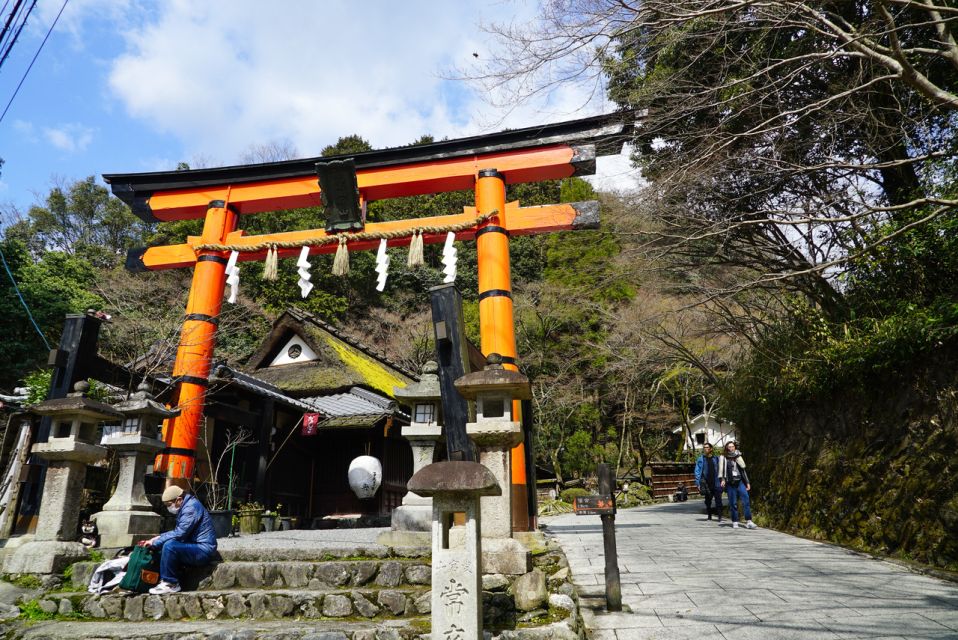
The tour guide shares intriguing local stories and legends with participants during the Arashiyama walking tour. These stories and legends are an integral part of the local traditions and hold cultural significance in the Arashiyama area.
As the guide leads the group through the tour, they provide fascinating insights into the history and folklore of the region. Participants learn about the ancient customs and beliefs that have been passed down through generations. They discover the hidden meanings behind certain landmarks and gain a deeper understanding of the local culture.
These stories and legends not only add an element of excitement to the tour but also offer a unique perspective on the rich heritage of Arashiyama.
Frequently Asked Questions
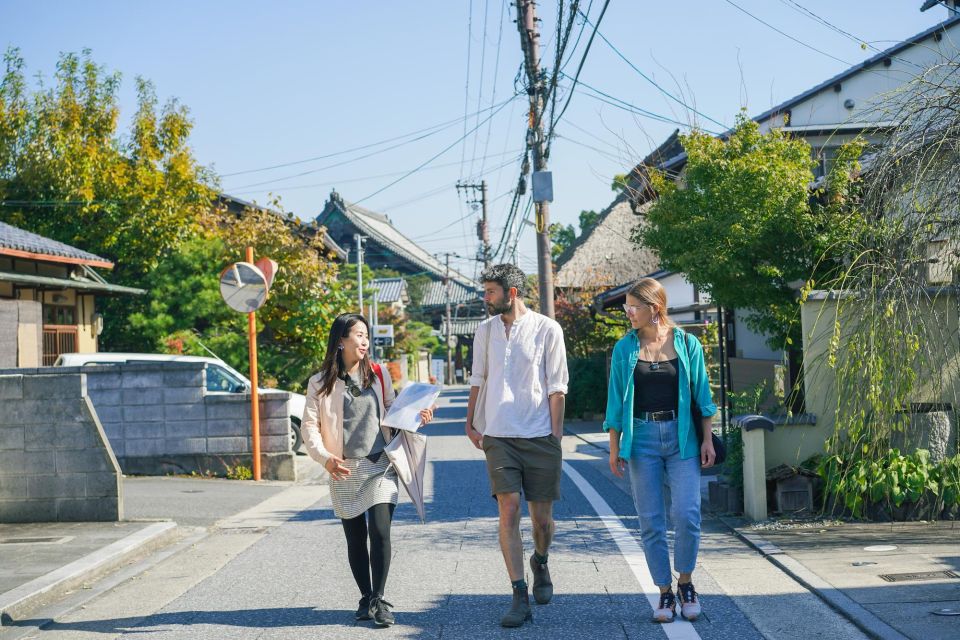
What Is the Maximum Number of Participants Allowed on the Arashiyama Walking Tour?
The maximum number of participants allowed on the Arashiyama walking tour is 7. The tour guide can speak both English and Japanese, ensuring a smooth and informative experience for all participants.
Can the Tour Guide Speak Any Other Languages Besides English and Japanese?
Yes, the tour guide can speak other languages besides English and Japanese. They are able to accommodate language preferences for travelers, making the tour accessible and enjoyable for a wider range of visitors.
Is the Lunch Included in the Price of the Tour or Is It an Additional Cost?
The lunch cost is included in the price of the tour. Participants can enjoy a traditional Kyoto-style meal with a special view of the Togetsukyo bridge. The tour guide can speak English and Japanese.
How Long Is the Visit to Tenryu-Ji Temple and Its Garden?
The visit to Tenryu-Ji temple and its garden on the Kyoto: 4-Hour Arashiyama Walking Tour lasts approximately 45 minutes. The maximum number of participants is 7, and the lunch cost is included in the tour price.
Are There Any Age Restrictions for Participating in the Arashiyama Walking Tour?
There are no age restrictions for participating in the Arashiyama walking tour. People of all ages can join as tour participants and enjoy exploring the beautiful sights and attractions of Arashiyama.
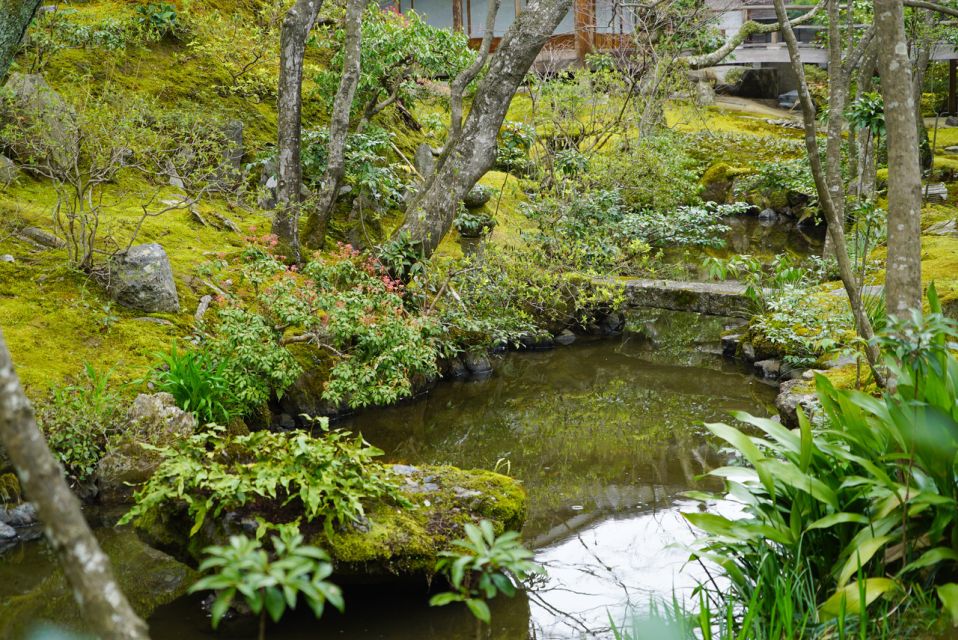
To sum it up, the ‘Kyoto: 4-Hour Arashiyama Walking Tour’ offers a unique and immersive experience for visitors in Kyoto. By exploring the lesser-known side of Arashiyama with a knowledgeable local guide, participants can explore the area’s rich culture, history, and natural beauty.
From visiting the stunning Tenryu-Ji temple to enjoying an authentic Kyoto-style lunch with a view of the iconic Togetsukyo bridge, this tour provides an enriching and memorable experience for travelers seeking to truly understand and appreciate Kyoto.
Related Posts

- December 31, 2023

Private Miyajima Oyster and Sakurao Whisky Distillery Tour

Seasonal Shuttle to Minami-Sado
Trending now.

- Media & Industry
- Meetings & Events
- Select Language 简体中文 繁體中文(香港) 繁體中文(臺灣) India (English) Bahasa Indonesia 한국어 ภาษาไทย Tiếng Việt Singapore (English) Philippines (English) Malaysia (English) Australia/New Zealand (English) Français Deutsch Italiano Español United Kingdom (English) Nordic countries(English) Canada (English) Canada (Français) United States (English) Mexico (español) Português العربية Japan(日本語) Global (English)
- India (English)
- Bahasa Indonesia
- Singapore (English)
- Philippines (English)
- Malaysia (English)
- Australia/New Zealand (English)
- United Kingdom (English)
- Nordic countries(English)
- Canada (English)
- Canada (Français)
- United States (English)
- Mexico (español)
- Global (English)
- Fujiyoshida
- Shimonoseki
- Ishigaki Island
- Miyako Island
- Kerama Island
- Tokyo Island
- Koka & Shigaraki
- Hida Takayama
- Ginza, Nihonbashi
- Beppu & Yufuin (Onsen)
- Ginzan Onsen
- Nagasaki Islands

- Kumano Kodo
- Shikoku Karst
- Amami Oshima
- Hachimantai
- Omihachiman
- Aizuwakamatsu

- Diving in Japan
- Skiing in Japan
- Seasonal Flowers in Japan
- Sustainable Outdoors
- Off the Beaten Track in Japan
- Scenic Spots
- World Heritage
- Home Stays & Farm Stays

- Japanese Gardens
- Japanese Crafts
- Temple Stays
- Heritage Stays
- Festivals and Events
- Theater in Japan
- Japanese Tea Ceremony
- Cultural Experiences in Japan
- Culture in Japan

- Local Cuisine Eastern Japan
- Local Cuisine Western Japan
- Local Street Food
- Japan's Local Ekiben
- Japanese Whisky
- Vegetarian and Vegan Guide
- Sushi in Japan Guide
- Japanese Sake Breweries

- Art Museums
- Architecture
- Performing Arts
- Art Festivals
- Japanese Anime and Comics
- Japanese Ceramics
- Local Crafts

- Scenic Night Views
- Natural Wonders
- Theme Parks
- Samurai & Ninja
- Iconic Architecture

- Wellness Travel in Japan
- Japanese Ryokan Guide
- A Guide to Stargazing in Japan
- Relaxation in Japan
- Forest Bathing (Shinrin-yoku)

- Experiences in Japan
- Enjoy my Japan
- National Parks
- Japan's Local Treasures
- Japan Heritage
- Snow Like No Other
- Wonder Around Japan

- Visa Information
- Getting to Japan
- Airport Access
- COVID-19: Practical Information for Traveling to Japan
- Anime Tourism
- Countryside Stays
- Accessible Tourism
- Hokkaido Great Outdoors
- Scenic World Heritage in Tohoku
- Shikoku’s Nature and Traditions
- Southern Kyushu by Rail

- Traveling by Rail
- How to Travel by Train and Bus
- JR Rail Passes
- Scenic Railways
- Renting a Car
- Sustainable Travel in Japan
- Travel Brochures
- Useful Apps
- Online Reservation Sites
- Eco-friendly Accommodation
- Luxury Accommodations
- Traveling With a Disability
- Hands-free Travel
- How to Book a Certified Tour Guide
- Volunteer Guides
- Tourist Information Center

- Japanese Manners
- Spring in Japan
- Summer in Japan
- Autumn in Japan
- Winter in Japan
- Cherry Blossom Forecast
- Autumn Leaves Forecast

- Japan Visitor Hotline
- Travel Insurance in Japan
- Japan Safe Travel Information
- Accessibility in Japan
- Vegetarian Guide
- Muslim Travelers
- Safety Tips

- JAPAN Monthly Web Magazine
- Arts & Cultures
- Nature & Outdoor
- Festivals & Events
- Insider Blog
- Things to do
- Local Guides
- Food & drink
- Traditional
- Hokuriku Shinetsu

My Favorites
${v.desc | trunc(25)}
Planning a Trip to Japan?
Share your travel photos with us by hashtagging your images with #visitjapanjp
- Sagano & Arashiyama
Arashiyama 嵐山
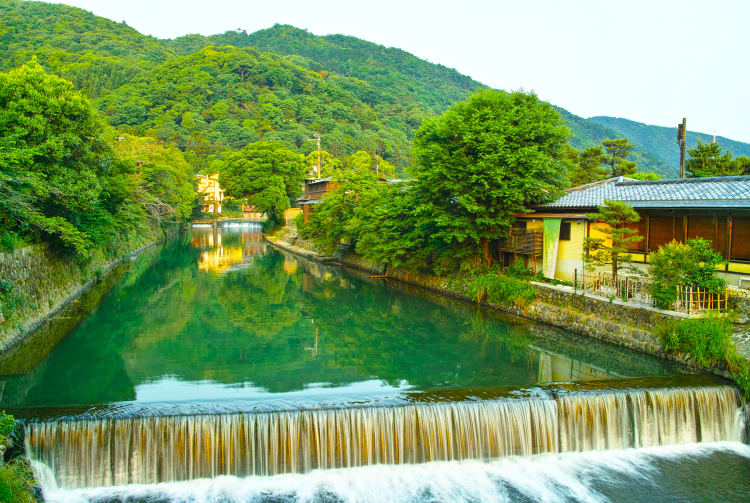
Ukyo-ku, Kyoto-shi, Kyoto-fu
- View on Google Maps
- Get Transit Info
Renowned for its bamboo grove, beautiful location and famous heritage
Located in the northwestern area of Kyoto, Arashiyama draws many visitors for its world-renowned bamboo grove and beautiful scenery that changes with each season. The area is dotted with temples, old imperial villas, and famous historical sites, many of which are National Treasures, or have been recognized as World Heritage sites. The entire region is designated by the Japanese government as a Place of Scenic Beauty.
- Togetsukyo Bridge—the great wooden landmark
- Walking among the towering stalks of Arashiyama Bamboo Grove
- Tenryu-ji—one of the greatest Zen temples of Kyoto
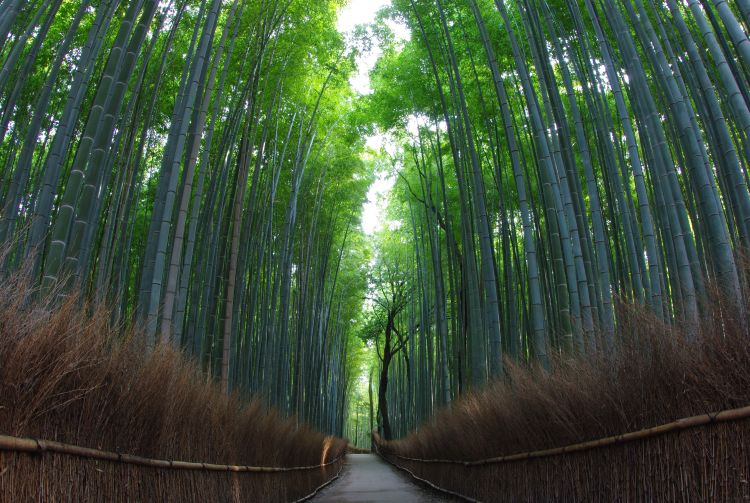
How to Get There
It can be reached on one of three railway lines: the JR Sagano Line which serves Saga Arashiyama Station; the Hankyu Line to Arashiyama Station; or the Keifuku Randen Tram Line.
Quick Facts
In the 13th century, Emperor Go-Saga had Yoshino's famous cherry trees moved here, making the area popular for cherry blossom viewing
There are light ups through out the year, where colored beams are thrown upon the hillsides and the over the top of the Arashiyama bamboo grove
The views from the top of the Iwatayama Monkey Park offer a stunning perspective of the distant Higashiyama mountainscape
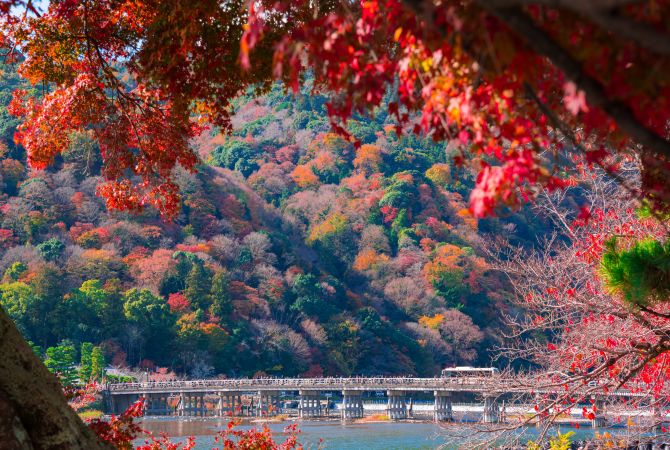
The poet's mount
Across from Arashiyama is Mt. Ogura, famed as the setting for the Ogura Hyakunin Isshu—a classical anthology of one hundred Japanese waka by one hundred poets who wrote one poem each. A card game adapted from the anthology is a popular and highly competitive pastime. Since ancient times, renowned poets such as Basho have pilgrimaged to Arashiyama.
Expansion outward to the natural world
Its garden is one of Kyoto's best, incorporating the surrounding mountains into its design, using the Japanese garden design concept of shakkei, or borrowed scenery. The exit at the back of the grounds leads directly to Arashiyama's world famous bamboo grove.
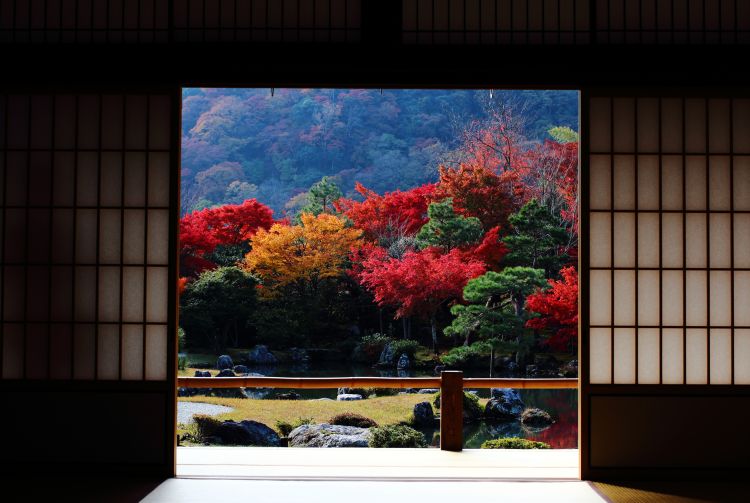
The promenade of heavenly bodies
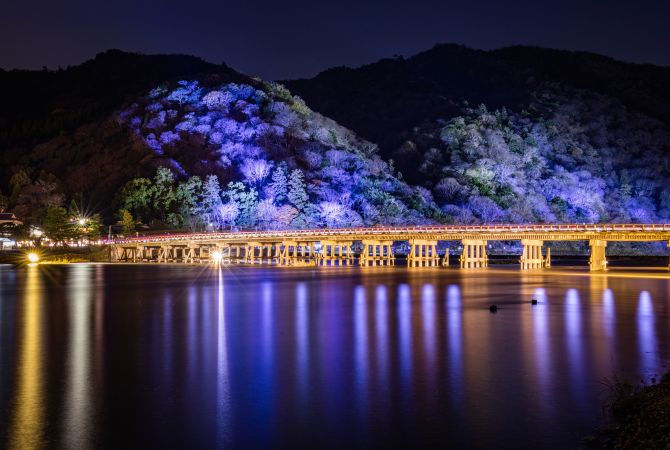
A journey up and down the river
A narrow-gauge train also runs along the river, and you should visit both to get a closer look at the ever-changing face of Arashiyama's natural landscape, celebrated by poets since ancient times.

An enjoyable visit to Arashiyama should be leisurely. Plan for a half or full day to take in the sights and not feel rushed through the idyllic setting.
* The information on this page may be subject to change due to COVID-19.
Recommended for You
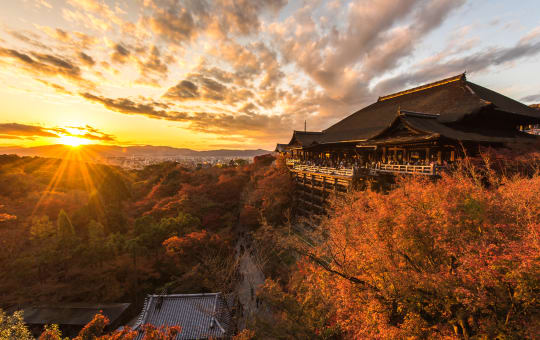
Please Choose Your Language
Browse the JNTO site in one of multiple languages
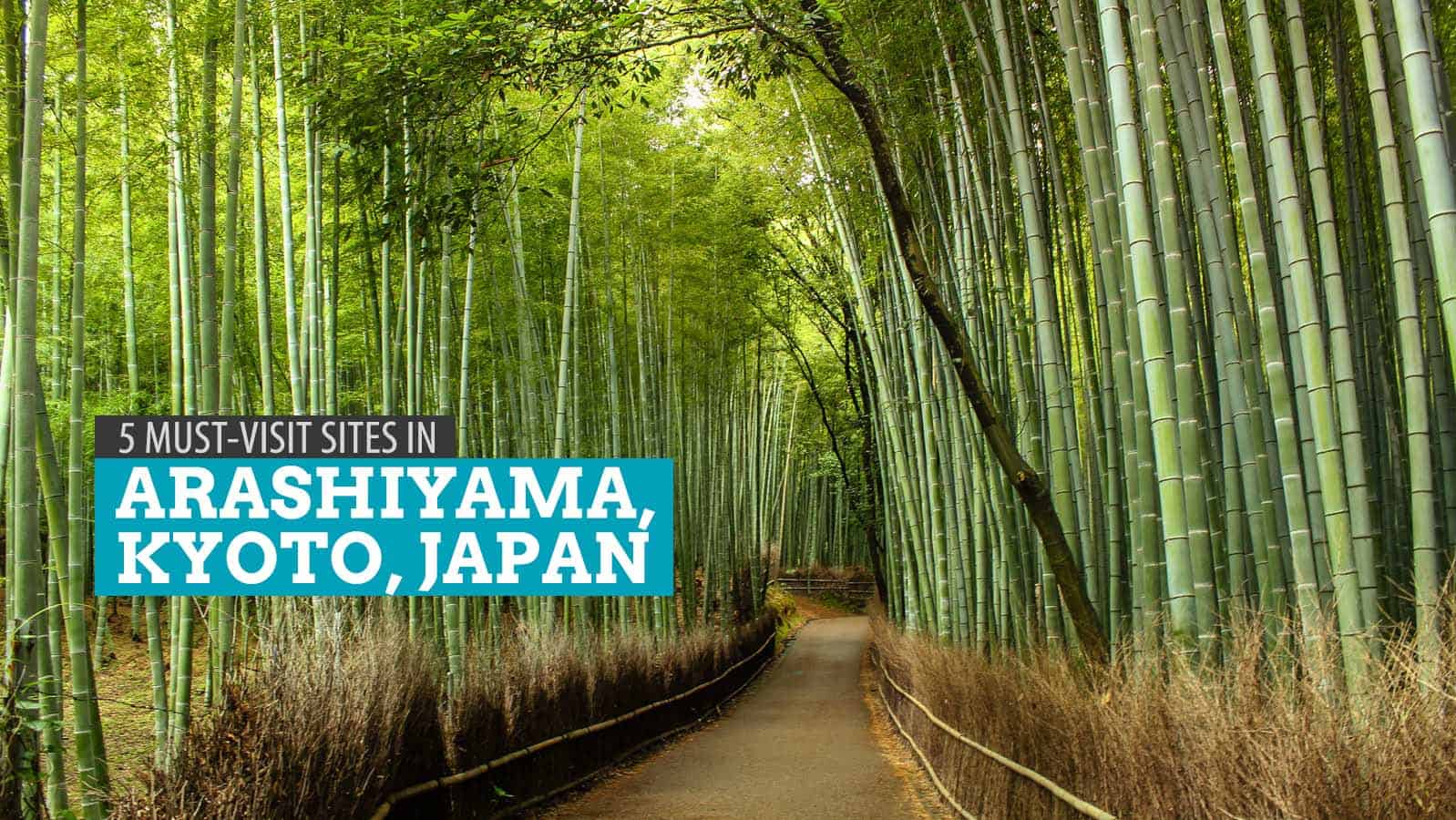
ARASHIYAMA, KYOTO: A DIY Walking Tour

There were four pictures hanging on a wall just outside Tenryuji Temple. Each frame showcased the visual character of the site per season — clad in the fiery colors of autumn, dressed in white snow in winter, adorned with the pink glow of cherry blossoms in spring, and, finally, drowned in a sea of verdancy in summer. Three of the four scenarios would have been such a first-time treat. I had never seen autumn leaves or snow or cherry blossoms. Unfortunately for me, it was midsummer.
The deciduous forest of the Arashiyama district was very lush and green — awfully green — during my visit. Green is great; I love green. But as a guy who hailed from a tropical island carpeted in evergreen rainforests, it was not really the color I was excited to bombard my eyes. The farther I walked into the place, the more I realized that it was a mistake booking June tickets to Japan. What was I thinking? Was I even thinking when I booked it? But kicking myself in the butt lasted for only a minute. Summer may not be the best time to be here, but the proverbial silver lining appeared amidst the greenery. There were fewer tourists, and the weather was pleasant, perfect for a long afternoon walk. That or I was just mastering the art of sweet lemoning. Tee-hee.
WHAT'S COVERED IN THIS GUIDE?
Togetsukyo Bridge
Straddling the Ōi River, the Togetsukyo Bridge is one of the most iconic pictures of Kyoto. In spring when cherry blossoms decorate the banks of the river, the bridge makes for a postcard-perfect subject. Built in 836 to provide better access to the nearby Horinji Temple, it has become an iconic structure, representing the Japanese’s clinginess to the past and simple way of life. Its name, which means “Moon Crossing,” was bestowed upon it by Emperor Kameyama. Since then, it has seen feudal wars, hosted samurai battles, and inspired some of the best haiku poems.
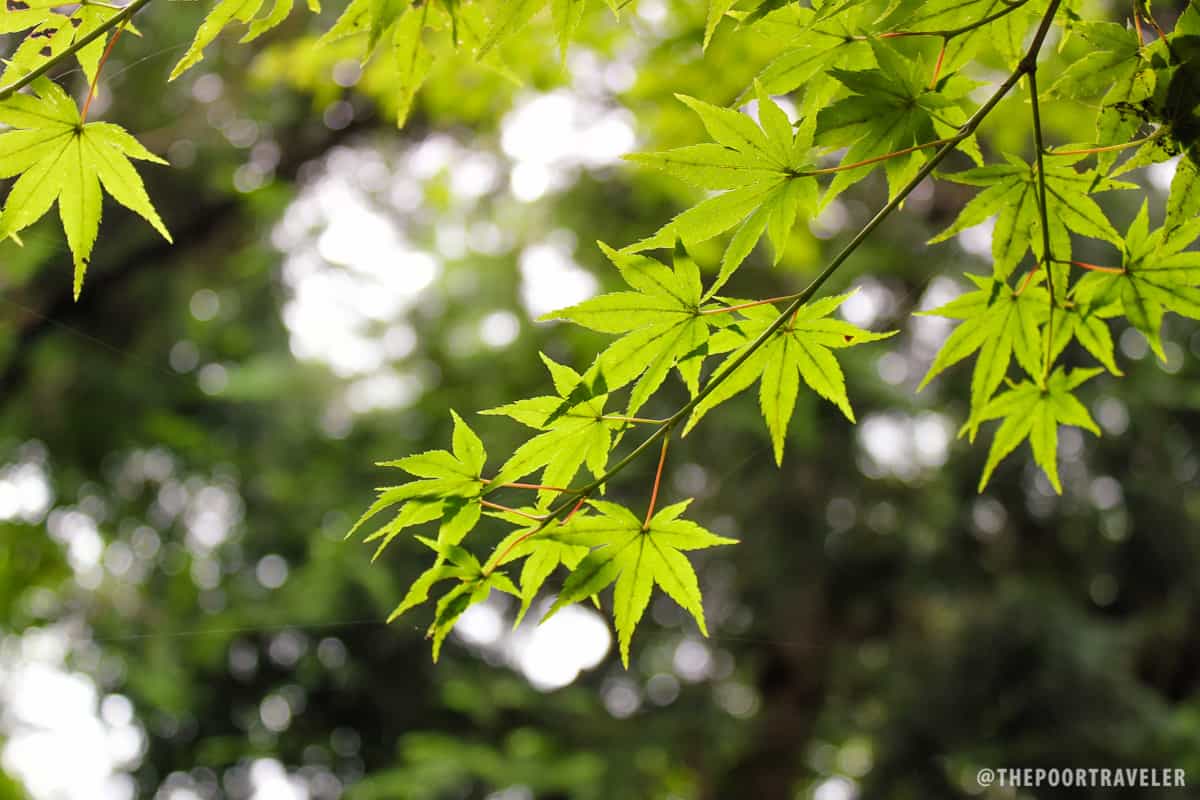
Horinji Temple
Sitting atop a hill overlooking Togetsukyo Bridge is Horinji Temple. It is one of the five head Shingon Buddhist temples in the city of Kyoto. According to legend, Emperor Genmei ordered the monk Gyoki to build it in the year 713. It was known as Kadonoidera Temple at the time. In 829, it became the new home of an image of Boddhisatva Akasagarbha (Kokūzō Bosatsu) and was since called Horinji Temple.
Save for the caretaker, there was nobody else at the temple despite the crowds flocking around the other temples in the area. Such a shame because its high elevation allows fantastic views of the district and even Kyoto.
Part of the reason it is not as frequented could be that it is concealed behind the trees at the far end of the bridge. Even I had a difficult time finding it. I was on the verge of giving up when a lovely vendor pointed us to the right direction. The temple is accessible via a narrow staircase that starts beside a traditional pastry store at the end of the Togetsukyo.
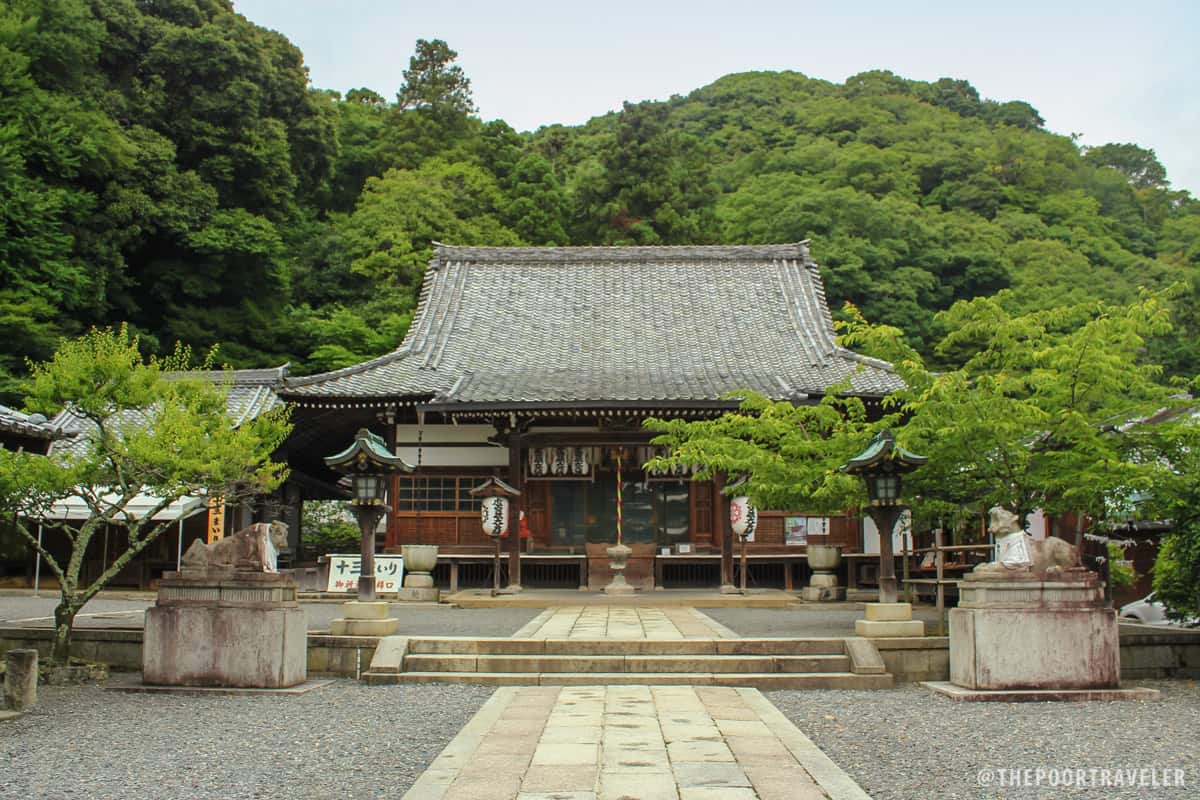
Tenryuji Temple
Regarded as the best among the Five Great Zen Temples of Kyoto, Tenryuji Temple has been declared by the Japanese government as a Special Place of Scenic Beauty and in 1994 was inscribed as a UNESCO World Heritage Site. It was originally founded in 1339 by Shogun Ashikaga Takauji as a place to console the spirit of Emperor Go-Daigo. Zen master Muso Soseki was the founding priest. Today, it is a major tourist destination, alluring everyone with its Zen beauty and tradition.
An exquisite garden encloses this temple, which makes the walk getting here an event in itself. Once again, I imagined how it looked during spring or fall as I strolled around it. Next to an abbey hall is the Sogen Pond, which is frequented by many species of birds. A large heron made an appearance at the pond while I sat by the hall.
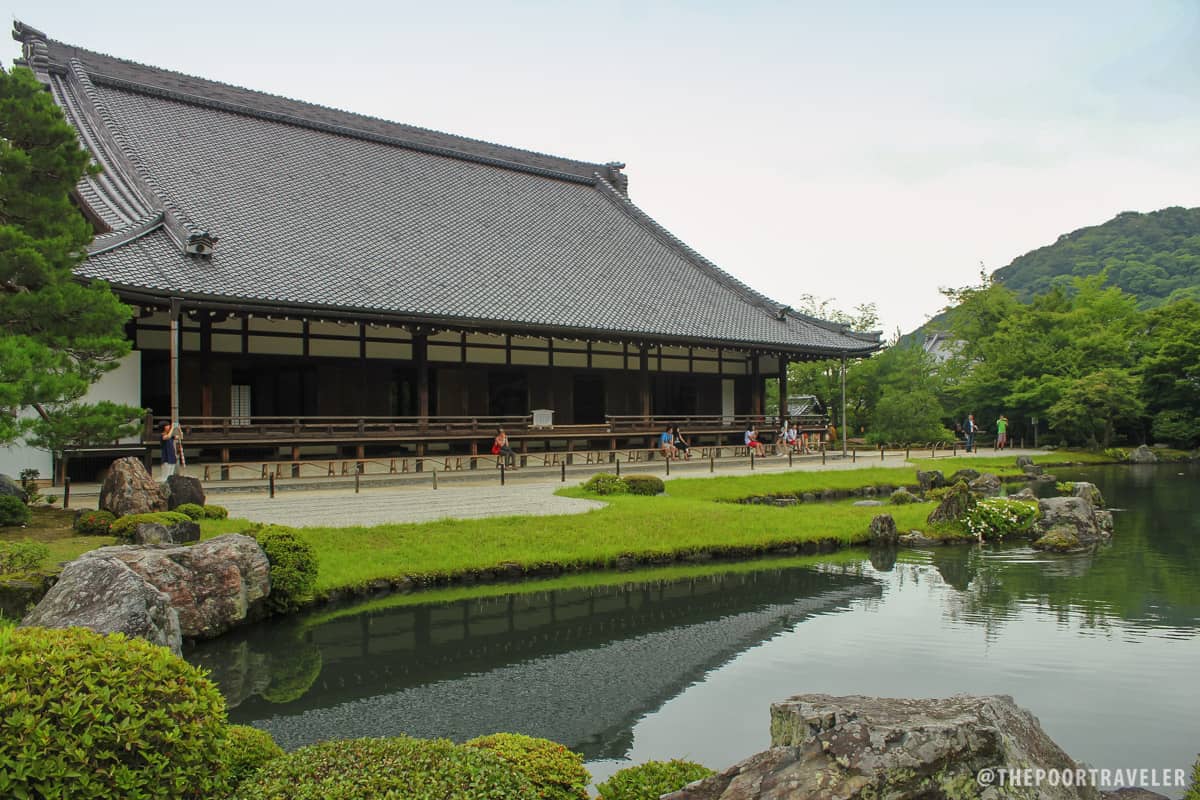
Nonomiya Shrine
Nonomiya Shrine means “Shrine in the Country.” A Shinto shrine, it was founded around 800 AD, but its location has changed through the years. It houses many images of gods, but the most notable are the god of marriage and the god of easy delivery. There used to be several nonomiya shrines, believed to be the temporary home of saios. In ancient Japan, a saio was an Imperial princess who was chosen to serve a god. This particular nonomiya sheltered a daughter of Emperor Saga in the late 8th century.
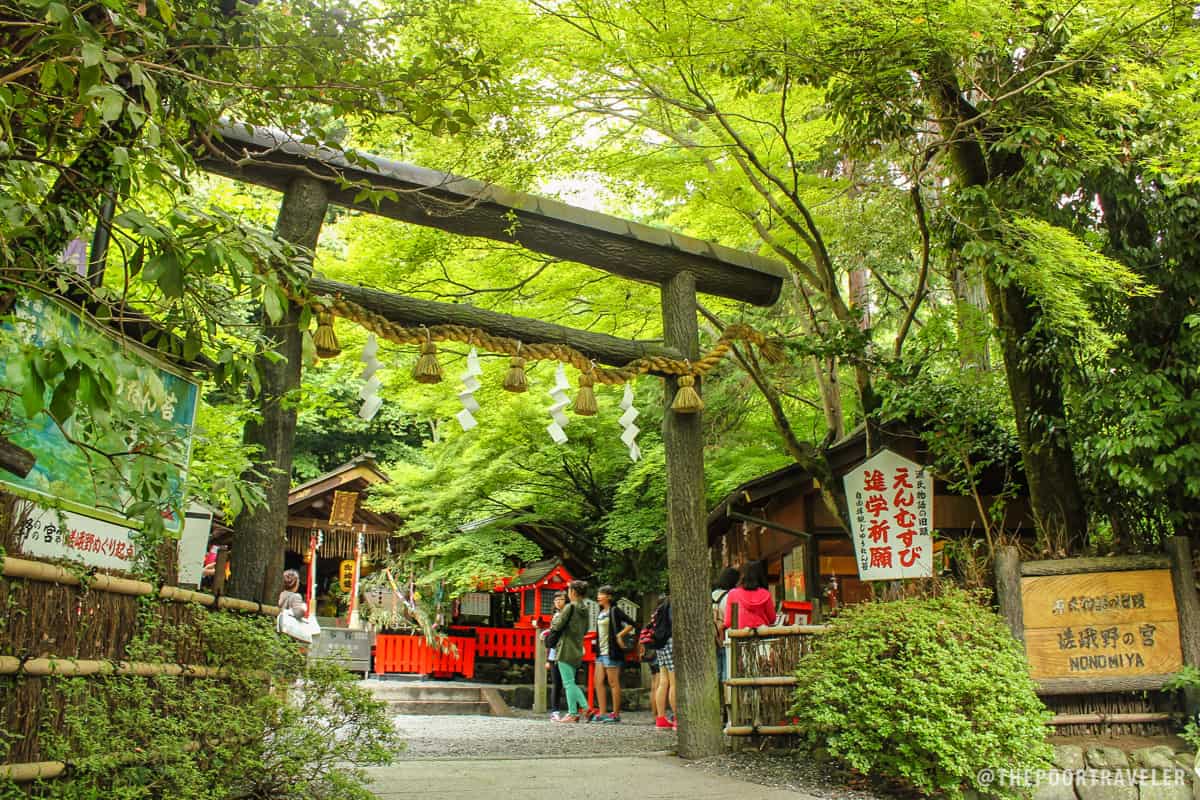
Bamboo Forest
Right after the garden exit is the start of the breathtaking groves of green bamboos. (Green again! But no one’s complaining now!) These imposing grass stalks towered above a narrow walking trail that meanders through it.
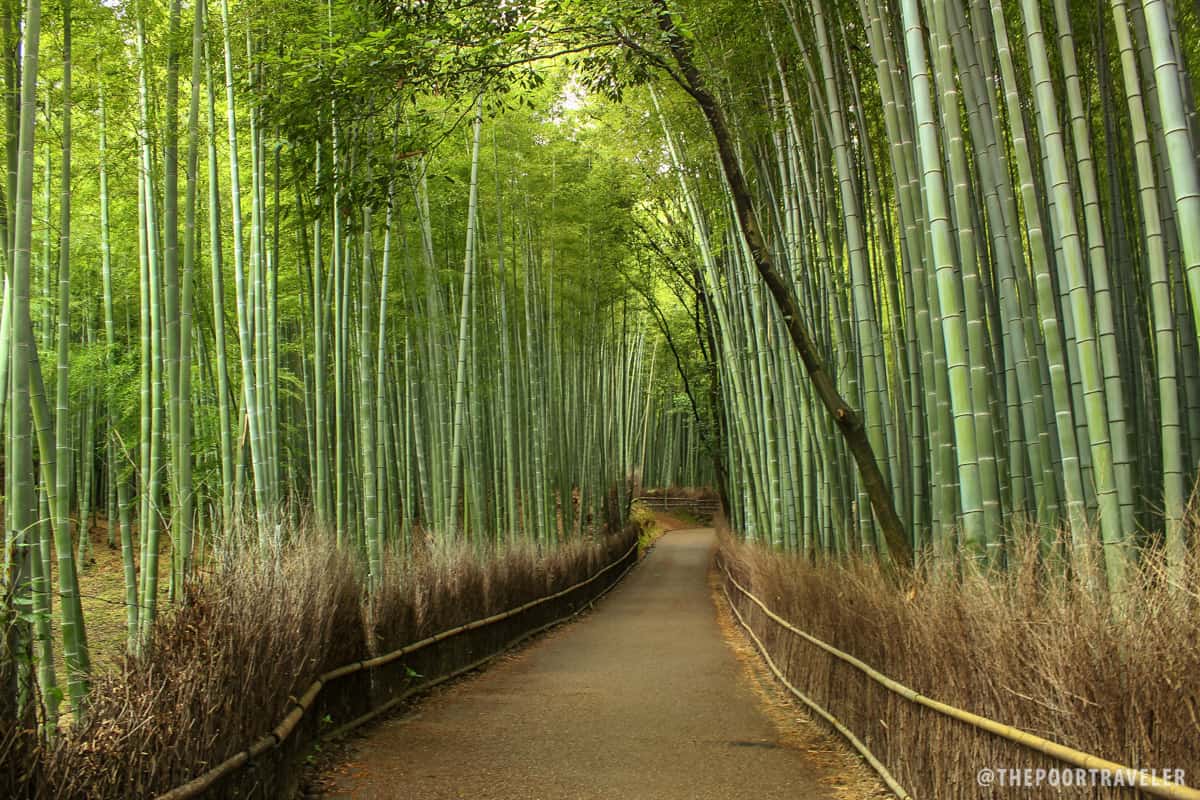
I had never seen any other place in Kyoto more picturesque and therapeutic than this! Bikers breezed through and lovers ambled sweetly under its thin canopy, enjoying a chlorophyll-colored dream. These bamboo trunks whispered gaieties that blew what was left of the summertime sadness that I carried in my heavy heart.
Arashiyama smothered me with a verdant pillow and I was ironically enjoying the way it took my breath away. Indeed, being here during summer had a silver lining, except it wasn’t silver at all. It was very, very green.
How to get to Arashiyama : From Kyoto Station, take the JR Sagano Line (aka JR Sanin Line) to Saga-Arashiyama Station. Travel time: 15 minutes. Fare: JPY 230. From the Sagaarashiyama Station, the central Arashiyama area can be reached on foot in 5 minutes.
More Tips on YouTube ⬇️⬇️⬇️
Is this post helpful to you?

Related Posts:
- GION DISTRICT, KYOTO: The Birthplace of Kabuki and Geisha
- TOEI KYOTO STUDIO PARK: Best Attractions & How to Get There
- 10 Food Delights to Try in Japan
- Donguri Okonomiyaki Dining in Kyoto, Japan
- Osaka Castle Park, Japan: Toyotomi’s Dream
- Tempozan Ferris Wheel: Sunny Surprises in Osaka, Japan
- Hotel Chuo Oasis in Osaka, Japan
- Snapshot: The Glico Man of Dotonbori – Osaka, Japan

- Recent Posts
- FLIGHT RESERVATION for VISA • How to Get Dummy Ticket for Schengen, Canada, China and Other Visa Applications - 22 March 2024
- 2024 Cebu Pacific Promos & PISO SALE with List of Covered Destinations - 4 March 2024
- Top 13 FREE Attractions to Enjoy in MACAU - 19 February 2024
Featured On

We heard you!
Your comment is now queued for moderation! We’ll try to get back to you soonest. While waiting, follow us on these channels.
Subscribe on Youtube! Follow us on Instagram!

Niigata's Murakami City: Enjoy Fun Events, Sightseeing, and Local Cuisine!
We use cookies to improve our contents. Check the detail and update your settings here .
We use cookies to improve our services.
For more details, please click here .

- Change setting
- Food & Drink
- Accommodation
- Things To Do
- All the categories
Transportation
- Weather & Seasons
- Long-Term Stay
- Travel Tips
- Event Tickets
- About MATCHA
- Company Profile
- Things To Do in Kyoto
- Food & Drink in Kyoto
- MATCHA Special Features
Arashiyama, Kyoto - Top Things To Do, Travel Tips, And Transportation

Arashiyama, Kyoto, is a popular area holding some of the ancient capital's most famous sites, like Tenryuji Temple, a lush bamboo grove, and countless historically and culturally significant structures. Learn what to do and tips for making it a great trip.
Kyoto, Japan
Arashiyama - Sightseeing, Activities, and Tips

Known prominently for its lush bamboo grove, Tenryuji Temple - a World Heritage Site, and old Japanese townscape, Arashiyama is a must-visit destination for many in Kyoto . Easily accessible via train from Kyoto Station, Arashiyama is an area constantly bustling with visitors, and is full of unique things to experience.
Continue reading to learn eight of the best spots in Arashiyama , food to try , and tips on traveling , including when to visit to avoid crowds and how to get there.
Guide to Arashiyama
8 Places to Visit 1. Arashiyama Bamboo Grove: Lose Yourself in a Forest 2. Tenryuji Temple: Be Dazzled by a World Heritage Zen Buddhist Temple 3. Arashiyama Monkey Park Iwatayama: Meet Adorable Animals 4. Togetsukyo Bridge: Capture Stunning Scenery 5. Sagano Scenic Railway: Ride a Charming Japanese Train 6. Okochi Sanso Villa: Visit a Historic Japanese Home 7. Jojakkoji Temple: Catch Your Breath at a Serene Spot 8. Gioji Temple: Appreciate A Tranquil, Lush Moss Garden
Street Food and Restaurants 9. Try Dango, Tofu Ice Cream, and Savory Snacks 10. Arashiyama Yoshimura: Enjoy Soba by the Riverside 11. Shigetsu: Experience Buddhist Temple Cuisine at Tenryuji 12. % Arabica Kyoto Arashiyama: Sip on Stylish Coffee and Lattes
Transportation and Tips 13. Best Times to Visit Arashiyama 14. Getting to Arashiyama from Popular Areas in Kyoto
1. Arashiyama Bamboo Grove: Lose Yourself in a Forest

The Arashiyama Bamboo Grove is perhaps the most iconic spot in Arashiyama, gaining international popularity through dazzling pictures shared on social media, hinting at its bright greenery and mystery. The bamboo forest is best seen in-person, though, as it will feel like you have entered another world when you walk down the paths. It is open 24-hours.
The grove stretches around 600 meters, running through Torokko Arashiyama Station, Tenryuji Temple , a major Zen temple in the area, through to Okochi Sanso Villa , the former Japanese home of a 19th-century actor. To get there, head north from Togetsukyo Bridge (mentioned below) after leaving the train.
Please note the forest paths can become very crowded during mid-day and during spring and fall. In December, the area is illuminated in the evenings, creating an even more mystical atmosphere.
2. Tenryuji Temple: A World Heritage Zen Buddhist Temple

Picture courtesy of Tenryuji Temple Tenryuji Temple is one of Japan's prominent Zen Buddhist temples, established in 1339. It is a registered UNESCO World Heritage Site for its cultural and historical significance. Visitors can explore many of the temple's buildings, including the famous cloud dragon mural in the Hatto (Dharma Hall). There is also a Japanese garden with an expansive pond surrounded by greenery that is gorgeous year-round.
This temple is a popular spot to visit and may become crowded on weekends and during peak travel season. Visitors can also try workshops for meditation and sutra copying , and enjoy shojin ryori (traditional vegetarian Buddhist food) at Shigetsu , the restaurant on the grounds. Please see the official website listed below for more information.

Picture courtesy of Tenryuji Temple
Tenryuji Temple is around a 13-minute walk from JR Saga Arashiyama Station or a 15-minute walk from Hankyu Arashiyama Station. Admission is 500 yen for the garden, and 300 yen to enter most buildings. It is 500 yen to see the Hatto, which is open generally on weekends and public holidays. Please check the official website for further information.
Hours are from 8:30 to 17:30 throughout the year, except for October 21 to March 20, when the temple is open 8:30 to 17:00. Last admission is 30 minutes before closing time.
Address: Kyoto, Ukyo, Saga Tenryuji, Susukinobaba 68 Google Map Website : http://www.tenryuji.com/en/
3. Arashiyama Monkey Park Iwatayama: Meet Adorable Animals

Picture courtesy of Arashiyama Monkey Park Iwayatama Arashiyama Monkey Park Iwatayama is a popular spot where visitors can see wild Japanese macaque monkeys wandering around on mountains overlooking Kyoto. This is a family-friendly , must-visit for any animal lover--the monkeys are adorable to meet in-person and will melt your heart.
As they are wild animals, however, take precautions for your safety as well as the animals. Visitors should not directly feed the monkeys outside of the designated area, touch, or crouch down to see the monkeys.
The monkey park is located around five minutes from Hankyu Arashiyama Station, or 15 minutes from JR Saga Arashiyama Station by foot. It is about a 20-minute hike uphill to get to the main area, so it is suggested to wear clothing and shoes for appropriate for climbing, and to store any luggage you have in a coin locker beforehand.

Picture courtesy of Arashiyama Monkey Park Iwayatama
The park is open from 9:00 to 16:00 from March 15 through September 30, and 9:00 to 16:00 from October 1 to March 14. Admission fee is 550 yen for guests 16 years and up, and 250 yen for children 4 to 15 years old (free for 3 years and younger).
Address: Kyoto, Nishikyo, Arashiyama, Nakaoshita 61 Google Map Website: http://www.monkeypark.jp/Englishpage.html
4. Togetsukyo Bridge: Capture Stunning Scenery

The picturesque Togetsukyo Bridge is a world-famous bridge representative of Kyoto. Spanning across the Oigawa River, the bridge greets visitors walking up from Hankyu Arashiyama Station towards the main destinations and shops.
It is a very popular spot for photography any time of the year, but the cherry blossom season and fall foliage are particularly popular, bringing in many visitors. If you want to avoid crowds in general, however, it is advisable to go to early in the morning. During Obon season in mid-August, glowing lanterns are floated down the river in the evening.
Address: Kyoto, Ukyo, Saga Nakanoshima Google Map
5. Sagano Scenic Railway: Ride a Charming Japanese Train

Ride the Sagano Scenic Railway , or Sagano Romantic train, for a picturesque ride through nature. The rail is around 7-kilometers one-way, running between Torokko Arashiyama and Torokko Kameoka stations along the same river Togetsukyo Bridge spans.
The antique-style trains operate at a slow speed that allows riders to enjoy the surrounding scenery during the 25-minute long ride. Torokko Kameoka Station leads to Kameoka, a city separated from the main Kyoto area with stunning natural landscapes.
To use the Sagano Romantic train, head to Torokko Arashiyama Station or Torokko Saga Station . Tickets for the train can be bought the day of, or purchased at the Midori no Madoguchi at JR train stations across Japan.
It is recommended to try riding in "The Rich" car, which has a glass ceiling and no windows, allowing riders to see more of the scenery. Tickets for these seats are available for purchase only at Torokko stations on the day you want to ride.
Website: https://www.sagano-kanko.co.jp/en/
6. Okochi Sanso Villa: Visit a Historic Japanese Home

Picture courtesy of Okochi Sanso Villa Okochi Sanso Villa is the former part-time residence of Okochi Denjiro (1898 - 1962), a famous actor known for his appearances in Japanese historical drama films in the early 20th century. The villa has been kept in pristine condition and is recognized nationally for its cultural importance.
A tea house and a garden on the grounds allow visitors to experience the villa with all the senses. You will feel relaxed walking through the home and the grounds, preparing for your next destination.

Picture courtesy of Okochi Sanso Villa Admission to Okochi Sanso Villa is around 1,000 yen, which includes a matcha set with a Japanese sweet . You can visit Okochi Sanso Villa from 9:00 to 17:00, and the villa is open throughout the year. It is around a 15-minute walk from JR Saga Arashiyama Station to the villa, or directly accessible from Torokko Arashiyama Station.
Address: Kyoto, Ukyo, Saga, Ogurayama, Tabuta 8 Google Map
7. Jojakkoji Temple: Catch Your Breath at a Serene Spot

Picture courtesy of Jojakkoji Temple Jojakkoji Temple is a temple known for its abundant nature and stunning buildings. The precincts contain buildings dating back to the 17th century and before. In addition, the Niomon gate was constructed in the 14th century, showing the historical prominence of the temple .

Picture courtesy of Jojakkoji Temple The precinct is filled with trees and flowers, making Jojakkoji Temple an ideal place to visit any time of the year. The fall is particularly stunning, as is early summer, when pink varieties of azaleas are in bloom, contrasting brilliantly with the vivid moss-covered terrain.
Jojakkoji Temple is a five-minute walk from the Arashiyama Bamboo Grove. Guests can enter the grounds from 9:00 to 17:00 (last entry at 16:30) for 500 yen.
Address: Kyoto, Ukyu, Saga, Ogurayama 3 Google Map Website: https://www.jojakko-ji.or.jp/
8. Gioji Temple: Appreciate A Tranquil, Lush Moss Garden

Picture courtesy of Gioji Temple Another well-known site in Arashiyama is Gioji Temple , standing out with its thatched roof huts and vast moss garden. Gioji Temple is mentioned in "The Tale of Heike," a famous Japanese narrative of the 12th-century Genpei War. It is considered a very scenic spot in Arashiyama and is sure to take away visitors' breaths with its beauty.

Picture courtesy of Gioji Temple Gioji Temple is open from 9:00 to 17:00 (last admission at 16:30). Visitors can view Gioji Temple and Daikakuji Temple , an associated temple, with a joint admission ticket for 600 yen. The two temples are about 25 minutes apart on foot.
Address: Kyoto, Ukyo, Sagatori imoto, Kozaka 32 Google Map Website: http://www.giouji.or.jp/en
9. Try Dango, Tofu Ice Cream, and Snacks

Arashiyama is a great spot to try Japanese food and local Kyoto varieties of dishes. In particular, the area around Togetsukyo Bridge is especially convenient for finding street food and snacks.
Some of the most popular are dango (rice flour dumplings on skewers), often topped with red bean paste, or sweet and savory mitarashi glaze. There are also seasonal varieties and different options depending on the place.
One unique dessert you can try is tofu ice cream . Kyozuan is a shop famous for its ice cream that can be held upside-down without falling.
For savory treats, try the freshly-fried croquettes--you will find them at several stands with different types of meat-based filling. They are easy to hold while you explore Arashiyama.
10. Arashiyama Yoshimura: Enjoy Soba Noodles by the Riverside

Picture courtesy of Soba Restaurant Arashiyama Yoshimura Soba Restaurant Arashiyama Yoshimura is located steps away from the Togetsukyo Bridge, right by the Katsuragawa River. Specializing in soba (buckwheat) noodles, diners can choose from a variety of soba sets that come with fish, tempura, and pickled Kyoto vegetables depending on the option. There is an English, Chinese, and Korean menu available.
The restaurant is open from 11:00 to 17:00 daily, but it is advised to confirm operation times on the website.
Address: Kyoto, Ukyo, Saga Tenryuji, Susukinobaba 3 Google Map Website : http://yoshimura-gr.com/soba/index.php (Japanese)
11. Shigetsu: Experience Buddhist Temple Cuisine at Tenryuji

Picture courtesy of Tenryuji Temple Shigetsu is a restaurant located on the grounds of Tenryuji Temple by the garden. Diners here can experience shojin ryori , which is traditional Zen Buddhist cuisine, featuring foods like tofu, in-season vegetables, and rice. Shojin ryori is vegetarian and vegan-friendly , so a meal here is an excellent choice especially if anyone you are with has dietary restrictions.
There are three choices on the menu, but some require reservations in advance for parties of two or more. Pictured above is the Yuki set, which can be enjoyed without advanced notice. Please check the official website for more options.
Shigetsu is open from 11:00 to 14:00, so make sure to come during lunch hours. It is open year-round.
Address: Kyoto, Ukyo, Saga Tenryuji, Susukinobaba 68 Google Map Website: http://www.tenryuji.com/en/shigetsu

12. % Arabica Kyoto Arashiyama: Sip on Stylish Coffee and Lattes

If you are craving a pick-me-up while in Arashiyama, head to % Arabica Kyoto Arashiyama . Located right by Togetsukyo Bridge, this coffee stand is part of a global coffee company that specializes in single origin coffee and stylish lattes . One of three locations in Japan, its picture-perfect riverside position and great coffee here have resulted in this branch becoming very popular.
There is usually a line of customers that can even wrap around the path, so come in the morning if you want to avoid the wait. The beverages are delicious and make for a great picture. The shop operates from 8:00 to 18:00 daily.
Address: Kyoto, Ukyo, Susukinobaba, Saga Tenryuji 3-47 Website: https://arabica.coffee/location/arabica-kyoto-arashiyama/
13. Best Times to Visit Arashiyama

As Arashiyama is a very popular Kyoto destination, visitors should be aware of potential crowds and the possibility of waiting in lines . In general, you can expect Arashiyama to be most crowded in afternoons, weekends, and public holidays. Ideal times to visit include weekdays and morning hours. If you are hoping to capture photography of the landscape or certain sites without people, try to come as early as you can in the day .

14. Getting to Arashiyama from Popular Areas in Kyoto

Located around nine kilometers northwest of central Kyoto, it is relatively simple to get to Arashiyama, and travelers have a few different options to choose from.
If you want to get from JR Kyoto Station to Arashiyama, take the San'in/Sagano Main Line bound for Kameoka or Sonobe. Get off at Saga Arashiyama Station. It takes 17 minutes on the local train and 11 minutes if you are on a rapid train. The fare is 240 yen one way, but if you have a valid Japan Rail Pass it will be free.
Travelers coming from Gion or the Kawaramachi area should use the Hankyu line. Depart on a train heading to Umeda from Hankyu Kawaramachi Station. Transfer to the Arashiyama line at Katsura Station and get off at Arashiyama Station. The total ride takes 14 minutes and costs 220 yen one way.
A third option is to use the Randen , a tram that runs from central Kyoto to Arashiyama. Ride if you want to visit spots like Ryoanji Temple , with its iconic Zen rock garden. From Ryoanji, ride the Kitano Line, and transfer at Katabiranotsuji Station to the Arashiyama Line. It costs 220 yen and takes around 25 minutes.
Take in the Best of Arashiyama, Kyoto
Without a doubt, Arashiyama is a place travelers should not miss when visiting Kyoto. Easily accessible and full of temples, traditional buildings, and food options, this is an ideal place to spend a day or half day. It is a popular area that does become crowded, however, so be sure to plan a trip itinerary that works with your travel style.

An awkward Southern California native living in Osaka. Originally came to Japan on the JET Program in Hyogo Prefecture (Kansai) after studying economics in college, and decided to try to stay.
IUC 10-month program graduate. Vegan and interested in all things Japan-related. Left-handed. Very fond of Kansai.
Related topics
Top articles.

How to Travel to Kyoto From Osaka: The Fastest and Cheapest Ways

Kyoto in Autumn: Top 12 Fall Foliage Spots in 2023

Shopping in Kyoto: Top 16 Department Stores, Malls, and Shopping Streets

Related Article

Top 45 Cherry Blossom Spots in Japan - 2024 Guide

Hiroshima: 35 Things to Do and Travel Tips

Tokyo Travel Guide 2024: Top 35 Things to Do

Kyoto: 15 Must-Visit Temples and Shrines

Kyoto: 50 Things to Do, Places to Visit, Hotels, and Travel Tips

Guide to Uji, Kyoto's Town of Tea: The Phoenix Hall, Green Tea, and More

Kyoto Travel Tips: Transportation and Major Sightseeing Areas
Start planning your trip
Special Features

Popular Searches
Latest news.

Showa Kinen Park Flower Festival 2024: Enjoy Nemophila, Tulips, and More!

A Must for Nature Lovers! Win a Free Stay at Unzen Amakusa National Park

A World of Light and Color! Van Gogh Alive in Japan 2024

Cherry Blossom Light-up in Tokyo! Yomiuri Land's Jewellumination

Cherry Blossoms and Sky Lanterns! Aichi Hanami Lights 2024

Japan's Public Holidays and Long Weekends in 2024

Tokyo's Fall Foliage: Top 10 Gardens and Parks in 2023

How to Travel to Osaka from Tokyo in 2024: Price Comparison

Shinkansen: How to Buy Bullet Train Tickets
New articles.

"Seasonal Oden Jun" pioneers a new food culture in Kanazawa

[First Saturday event!] The 4th Ozu Night Ukai Bar

[12th Cui Yan Guang Recital & Blissful Dinner Report]

[Gold-Guide] Recommended Spring Kyoto Tours

[Hyogo] A guide to visiting Nana Farm Suma, located right next to Suma Seaside Park!
- Top Destinations
- Mexico City, Mexico
- Tokyo, Japan
- Paris, France
- Rome, Italy
- London, United Kingdom
- All Destinations
- Upcoming Experiences
- Walking Tours
- Small-Group Tours
- Tours for Kids
- Museum Tours
- Food, Wine and Market Tours
- Newly Added Tours
- Audio Guides
- Pre-Trip Lectures
- Admin Dashboard
- My Favorites
- Client Orders
- Monthly Commissions
- My Advisor Profile
- Advisor Toolkit
- Guide Dashboard
Credit Balance
Transactions are based on current exchange rates and performed in USD. There maybe slight variations in the price estimates.
Half-Day Arashiyama Day Trip from Kyoto, with Tenryu-ji and the Bamboo Grove

- Jojakko-ji Temple
- Tenryu-ji Temple
- Bamboo Grove
- Sogenchi Gardens
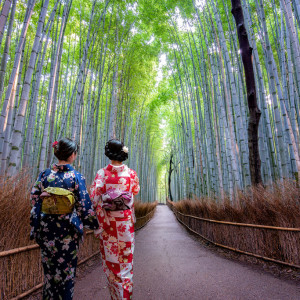
- From beliefs and customs, to paintings and literature, learn all about the Heian period's influence on Japanese culture
- Led by a local historian
Arashiyama Tour
Tenryuji, a top temple, basking in bamboo grove, views of kyoto.

Reviews can only be left by Context customers after they have completed a tour. For more information about our reviews, please see our FAQ .
Book a Tour
- Our Experts
- Working with Context
- View All Cities
- Sustainable Tourism
- Refer a Friend for $50
- Travel Updates
- Advisor Login
- Expert Portal
Subscribe to our Newsletter
- Privacy Statement & Security
- Cancellation Policy
Our website uses cookies to personalize your experience, perform analytics, and tailor ads. By clicking accept, you consent to our use of cookies. To view our data privacy policy, click here .
Our website uses cookies to personalize your experience, perform analytics, and tailor ads. By using our site, you consent to our use of cookies. To view our data privacy policy, click here .

Kyoto: 4-Hour Arashiyama Walking Tour
Discover the hidden gems of Arashiyama on the ‘Kyoto: 4-Hour Arashiyama Walking Tour’. Led by a knowledgeable local guide, this tour takes you on a journey through this enchanting district, known for its natural beauty and cultural landmarks.
Enjoy the tranquility of Tenryu-Ji temple, a UNESCO World Heritage Site, as you explore its stunning garden. Wander through the magical bamboo forest, feeling like you’ve entered another world.
Indulge in a traditional Kyoto cuisine lunch at a restaurant with breathtaking views of the iconic Togetsukyo bridge.
With a maximum of 7 participants, this small group tour ensures a personalized experience, and the guide is fluent in both English and Japanese.
Don’t miss out on this unforgettable adventure in Kyoto.
Quick Takeaways
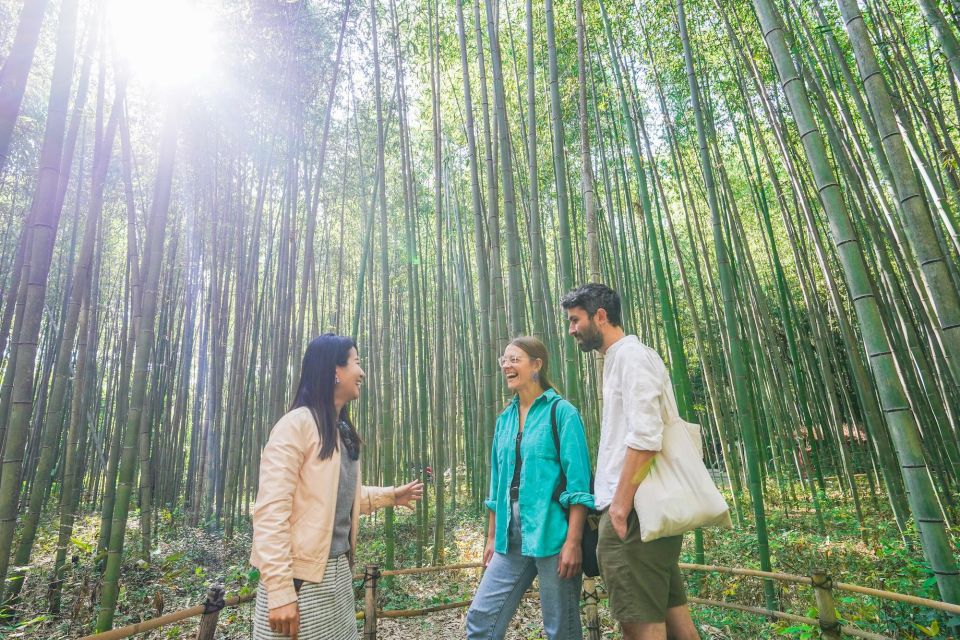
- Free cancellation available
- Explore a lesser-known side of Arashiyama with a local guide
- Enjoy an authentic, exclusive Kyoto-style lunch with a special view of the Togetsukyo bridge
- Small group activity limited to 7 participants for a personalized experience
Booking and Cancellation Information
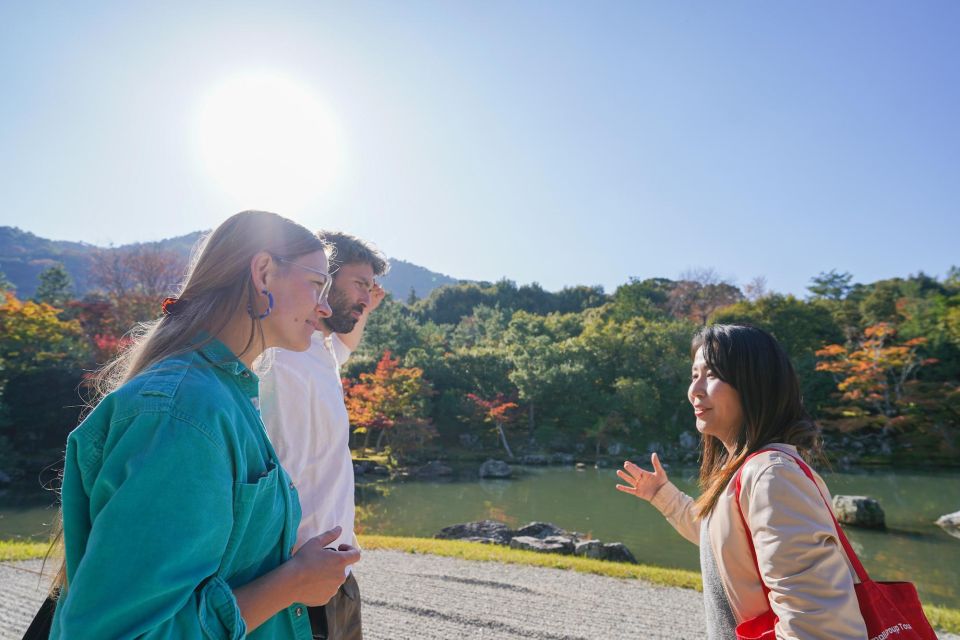
Cancellation for the Kyoto: 4-Hour Arashiyama Walking Tour is available free of charge and can be done up to 24 hours in advance for a full refund. This gives travelers the flexibility to change their plans if needed.
When booking the tour, visitors have various options to choose from. They can reserve now and pay later, allowing them to keep their travel plans flexible. This is especially helpful for those who want to secure their spot but may need to make changes closer to the date.
The refund policy ensures that participants can receive a full refund if they need to cancel within the specified timeframe. By offering these booking options and a generous refund policy, the tour give you a hassle-free experience for all participants.
Experience Highlights
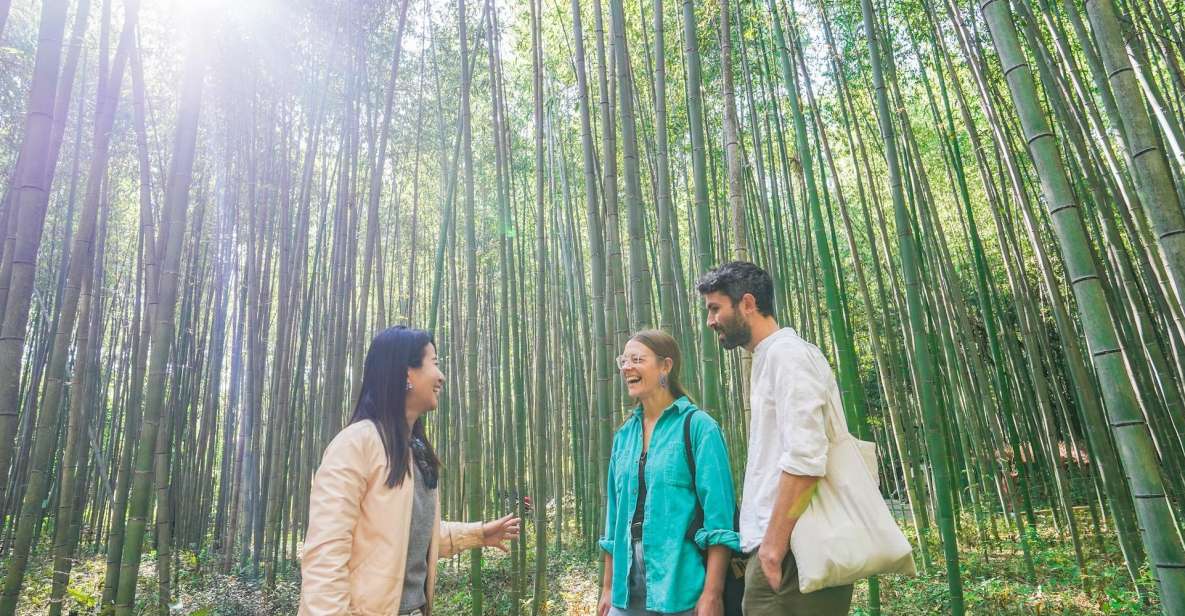
The tour’s experience highlights include:
- Exploring a lesser-known side of Arashiyama with a local guide
- Visiting the majestic Tenryu-Ji temple and its garden
- Enjoying an authentic Kyoto-style lunch with a special view of the Togetsukyo bridge
With a knowledgeable guide leading the way, participants can:
- Delve into the hidden gems and lesser-explored corners of Arashiyama
- Gain insights into the local culture and history along the way
The visit to Tenryu-Ji temple offers a chance to:
- Marvel at its stunning garden, known for its tranquil atmosphere and exquisite landscape design
And what better way to experience the essence of Kyoto than by:
- Indulging in a delicious Kyoto-style lunch
- Savoring traditional cuisine while enjoying a picturesque view of the iconic Togetsukyo bridge
This unique combination of exploration, culture, and culinary delight ensures an unforgettable experience in Arashiyama.
Detailed Tour Description
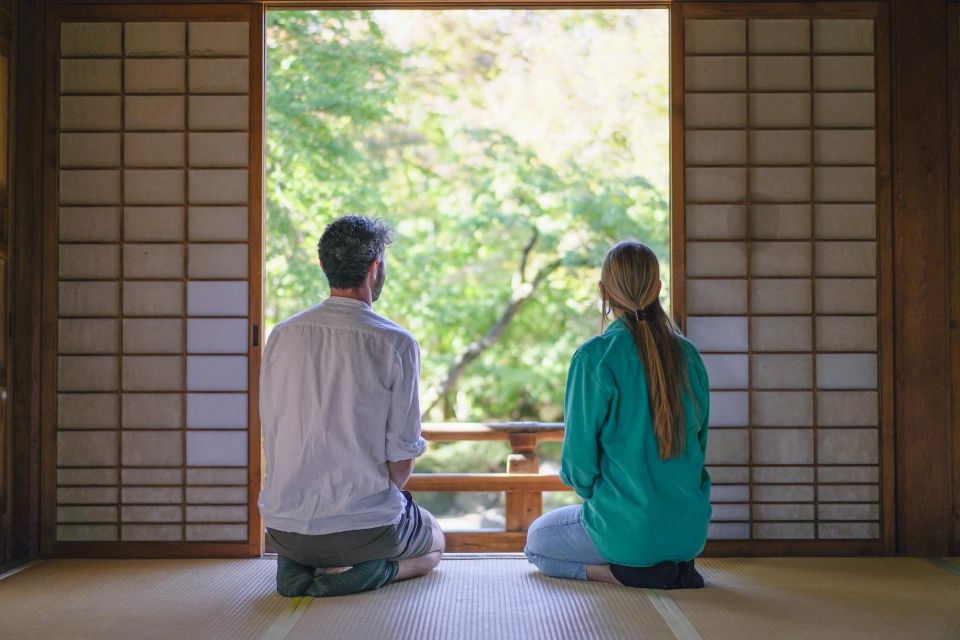
The tour takes participants on a journey through the lesser-known side of Arashiyama, led by a local guide. Starting in the Saga-Toriimoto area, away from the regular tourist route, visitors will have the opportunity to visit local gift shops, temples, and shrines.
The guide will share fascinating local stories and legends, adding depth and intrigue to the experience. The tour will then proceed to the famous bamboo forest, where the beauty and significance of the towering bamboo can be fully appreciated.
Next, you will visit Tenryu-Ji temple, a UNESCO World Heritage Site, known for its stunning Sogenchi pond and garden. A highlight of the tour is the chance to enjoy an authentic Kyoto-style lunch in a restaurant overlooking the iconic Togetsukyo bridge.
This is a great opportunity to savor the flavors of Kyoto cuisine while taking in the picturesque scenery.
Small Group and Availability
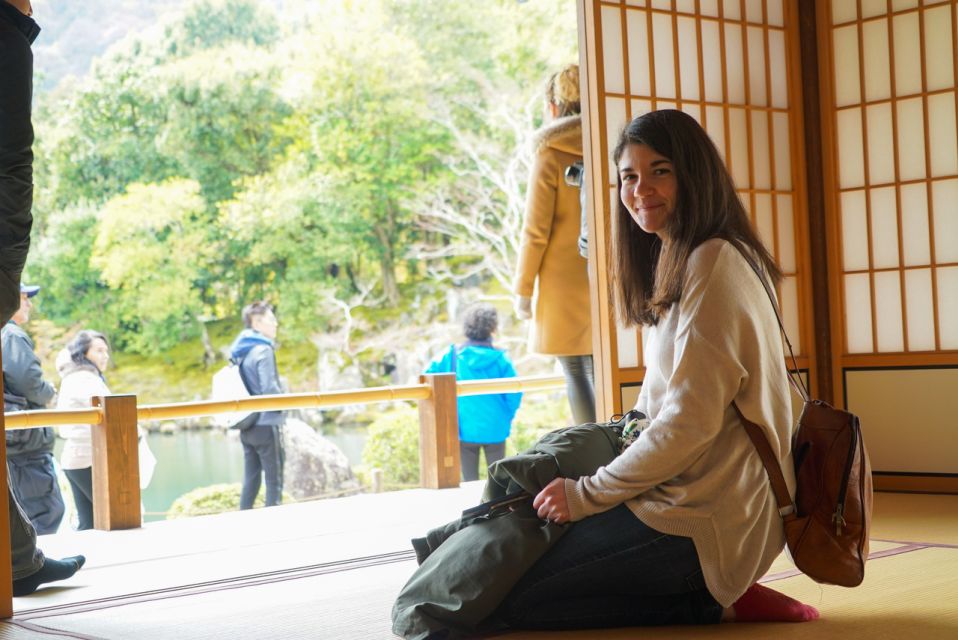
Availability for the small group Arashiyama walking tour can be checked to see the starting times. By booking in advance, visitors can secure their spot and guarantee their place on the tour. The small group size of 7 participants ensures a personalized and intimate experience for each traveler. The limited group allows for easier interaction with the knowledgeable tour guide, who can provide personalized attention and answer any questions along the way. Checking availability ahead of time also allows travelers to plan their schedule accordingly and choose a time that best suits their needs. Whether it’s a morning or afternoon tour, the availability schedule provides flexibility for visitors to explore Arashiyama at their own pace.
Duration and Additional Information
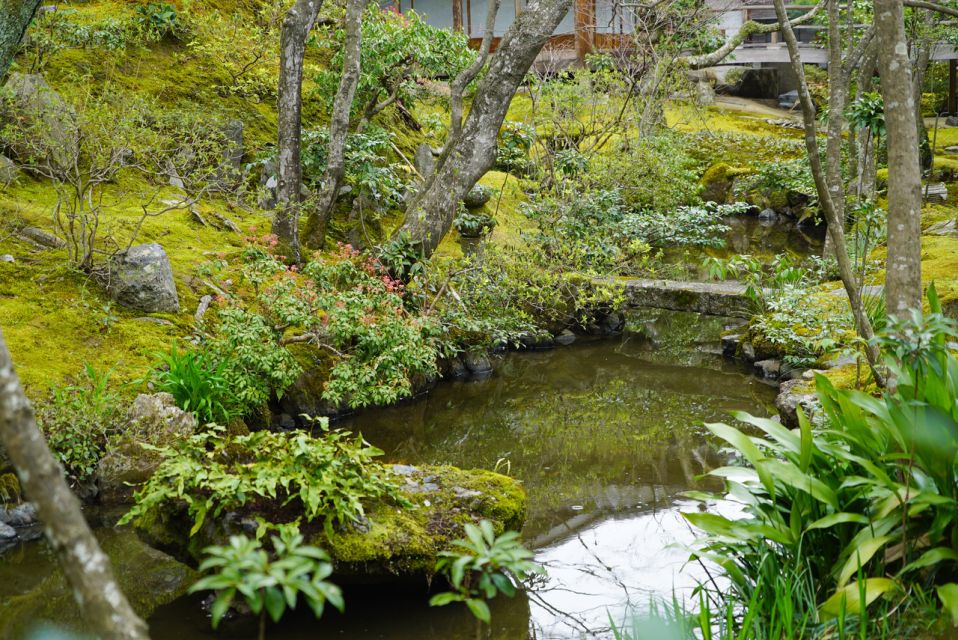
The duration of the activity is 5 hours.
This 4-hour Arashiyama walking tour in Kyoto offers a comprehensive experience of the area’s highlights. Led by a knowledgeable local guide, you will explore a lesser-known side of Arashiyama, starting from the JR Saga-Arashiyama station North Exit.
The tour takes you away from the regular tourist route, allowing you to visit local gift shops, temples, and shrines while learning about their stories and legends. One of the main attractions is the bamboo forest, where you can experience its beauty and significance.
You’ll also have the opportunity to visit the stunning Tenryu-Ji temple, a UNESCO World Heritage Site, and enjoy a traditional Kyoto-style lunch with a special view of the Togetsukyo bridge.
The tour is limited to 7 participants, ensuring a personalized experience. Don’t forget to book in advance to secure your spot and enjoy this immersive tour.
Frequently Asked Questions
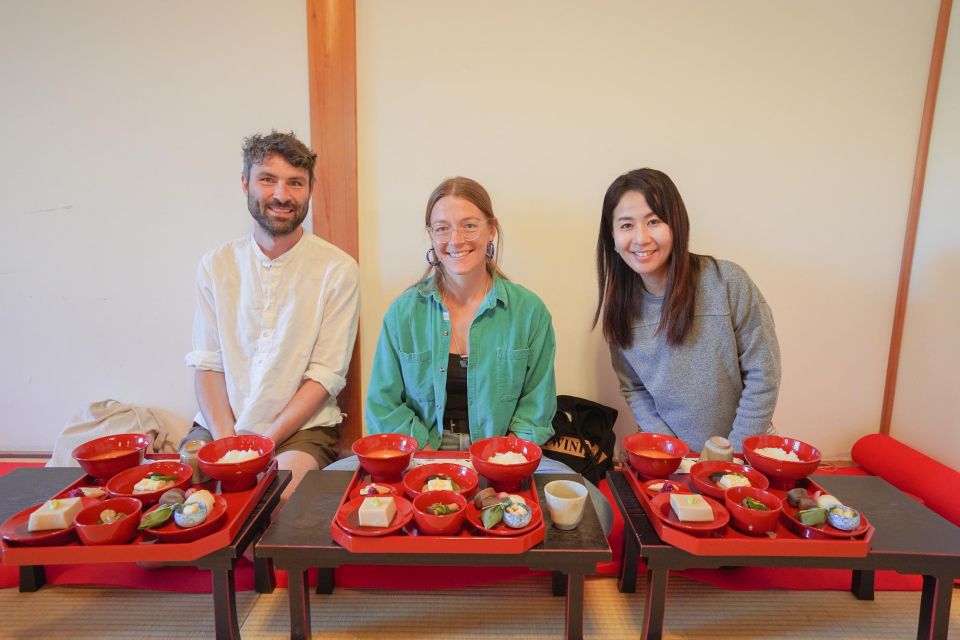
What Is the Best Way to Get to JR Saga-Arashiyama Station?
The best way to get to JR Saga-Arashiyama station is by train. Travelers can take advantage of the efficient and reliable train system in Kyoto. There are alternative routes available, depending on the starting point.
Are There Any Age Restrictions for Participating in the Tour?
There are no age restrictions for participating in the tour. The tour welcomes all ages, allowing families and individuals alike to explore Arashiyama’s hidden gems. Joining the tour requires no specific participation requirements.
Can I Bring My Own Food or Drinks on the Tour?
Yes, participants can bring their own food and drinks on the tour. However, it is important to note that there may be certain restrictions or guidelines regarding outside food and drinks.
Is There Any Special Dress Code for Visiting Temples and Shrines?
There is no specific dress code mentioned for visiting temples and shrines. However, it is generally recommended to dress modestly and respectfully, covering shoulders and knees, to show respect for the religious sites.
Are There Any Discounts Available for Children or Seniors on the Tour?
Yes, there are discounts available for children and seniors on the tour. However, it is important to note that there may be age restrictions for participating. It is recommended to check the tour details for specific information.
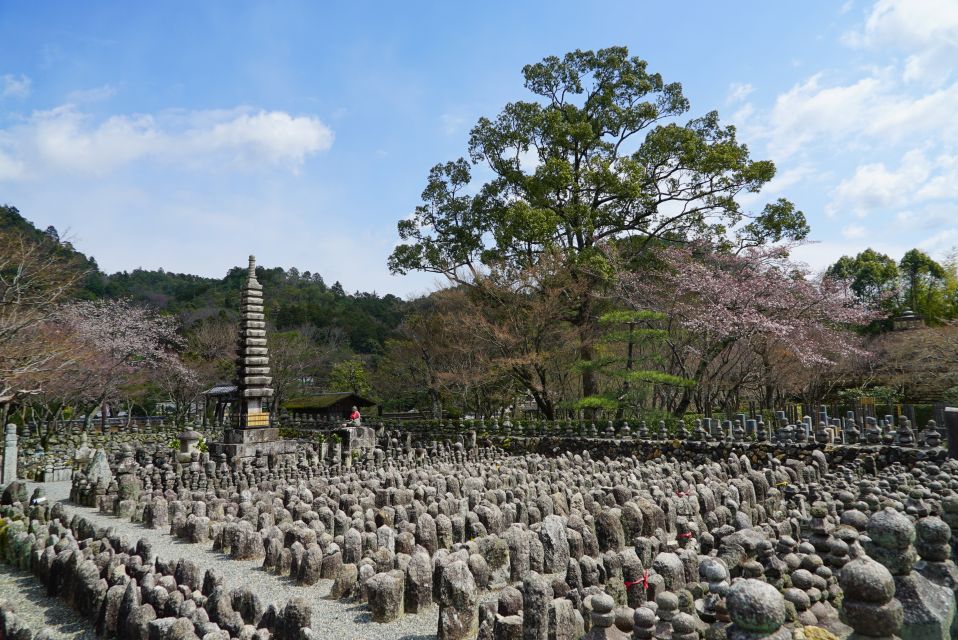
To sum it up, the Kyoto: 4-Hour Arashiyama Walking Tour offers a fantastic opportunity for travelers to explore the hidden gems of Arashiyama.
With a knowledgeable local guide, participants can discover the beauty of Tenryu-Ji temple and its stunning garden, as well as wander through the enchanting bamboo forest.
The tour also provides a chance to indulge in a traditional Kyoto cuisine lunch with breathtaking views.
With a small group size, personalized experience, and availability in both English and Japanese, this tour is a must-do for visitors to Kyoto.
Tokyo Trip Checklist
Similar posts.
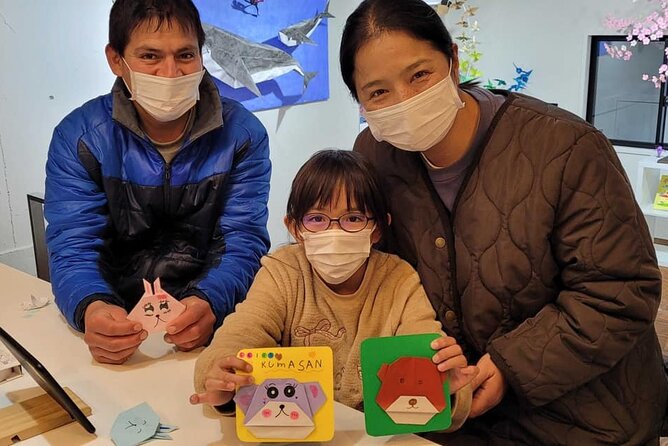
Family and Beginner Friendly Origami Experience in Asakusa
Located in the vibrant neighborhood of Asakusa, Taros Origami Studio offers a family and beginner-friendly origami experience that is as easy as folding a paper…
Nostalgia Tour Anime and Retro Gaming in Akihabara
Set out on a journey through the bustling streets of Akihabara, where the Nostalgia Tour Anime and Retro Gaming experience awaits. Imagine stepping into a…
Starry Sky Bath to Sora Sanpo
Nestled amidst the tranquility of the Kanucha Resort in Okinawa, Japan, lies an event known as the ‘Starry Sky Bath to Sora Sanpo.’ Participants are…
SkyExpress Private Transfer: Sapporo to Kiroro (8 Passengers)
Nestled amidst the tranquil beauty of Sapporo lies a gateway to adventure, beckoning travelers to embark on a seamless journey to Kiroro with SkyExpress Private…
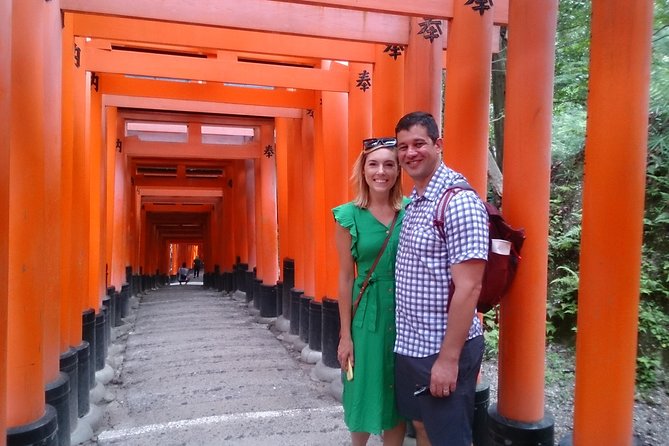
Kyoto Lazy Bird Tour
The Kyoto Lazy Bird Tour offers a refreshing option for travelers seeking a more laid-back experience. With a focus on freedom and relaxation, this tour…
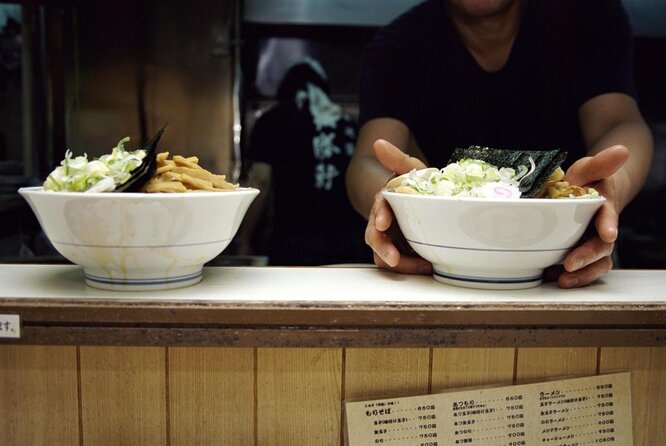
Tokyo Shopping Tour With a Local: Unique & Quirky Stores, Private & Custom
Set out on a Tokyo Shopping Tour With a Local: Unique & Quirky Stores, Private & Custom and learn about the vibrant shopping scene of…
Inside Kyoto
A Kyoto Travel Guide
- Kyoto Walking Tour 5: Arashiyama
Explore the stunning Kyoto district of Arashiyama, including the breathtaking Bamboo Grove, on this guided private walk.

This private Kyoto walking tour is ideal for people who want to see a lovely temple, Arashiyama’s famed Bamboo Grove, the most superb villa and garden in Kyoto and another small temple or two.
The Tour Itinerary
This route explores the Arashiyama area, Kyoto’s second-most popular sightseeing district, located at the base of the Western mountains. After marveling at the splendor of Tenryu-ji Temple , you’ll enter the magical Arashiyama Bamboo Grove , and then make your way up to sublime Okochi-Sanso Villa (my favorite private residence in all of Kyoto) before heading to one or two smaller Buddhist temples.

Your Own Private Tour Guide
Don’t forget this is a private walking tour, just for you and your friends and family. There will be no-one else on the tour with you, so you have the guide to yourself. We have some of Kyoto’s best English-speaking guides, helping you maximise your time and enjoyment of the city and also get a deeper understanding of the history and significance of each place you visit. The tour price is for the whole group, not per person!
- Time: Four hours
- Cost: ¥40,000 for 1 to 6 people per private group. The cost is NOT per person
- Highlights: Tenryu-ji Temple , Arashiyama Bamboo Grove , Okochi-Sanso Villa , Gio-ji Temple
- Ideal starting time: 9am (walk concludes at 1pm) or 1pm (walk concludes at 5pm)

How To Book A Kyoto Private Walking Tour
Please send us an inquiry using the form below. We will then quickly respond to you by email confirming availability and any other requirements you may have. You can pay either in advance online using your credit card, or you can pay at the conclusion of the tour in cash. Japanese Yen, US Dollars or Euros are acceptable for cash payments.
" * " indicates required fields
Frequently Asked Questions
Why hire a private guide.
You don’t need a guide to enjoy Kyoto, but having a guide will add a lot of depth to your understanding of the city. A guide will also free you from having to think about the logistics of getting around and making the most efficient use of your time. A guide can also help you enjoy local restaurants without any communication difficulties.
Hiring a guide for a tour on your first day will give you the confidence to explore on following days on your own and a guide can give you some advice about what to see later in your trip.
Who Runs These Tours?
My company Chris Rowthorn Tours provides these tours. We have been running licensed tours in Kyoto for 10 years. I have spent years finding and training the best guides in all of Kyoto. Licensed, professional bilingual guides who love Kyoto as much as I do. But, don’t take my word for it, have a look at reviews of Chris Rowthorn Tours on TripAdvisor .
Is The Price Per Person?
No! This is the PER GROUP price, i.e., it’s the price for a private group of 1 to 6 people. For example, if there is one person booking a four-hour walking tour, the price is ¥40,000 total. If there are six of you, the price is still ¥40,000 (making it much cheaper per person). The tour group is private. That means there is only you and your family or you and your friends on the tour and no one else. Please note that we do NOT put different individuals or groups together, even upon request.
Do I Get A Discount If We Are Less Than 6 People?
The price is for a private group for 1 to 6 people. There are no discounts if there are less than the maximum number of people.
How Do I Pay For My Private Kyoto Walking Tour?
Payment is in cash at the conclusion of the tour or by credit card in advance of the tour (we can set up credit card billing). If you choose to pay in cash, please note that we accept yen cash or the equivalent amount in US/Euro cash.
Can I Cancel A Tour After Booking It?
You can cancel a tour with no penalty up to 48 hours before the scheduled start of the tour. If you cancel between 24 and 48 hours of the scheduled start, we charge you 50% of the price of the tour. Cancellations made fewer than 24 hours from the scheduled start of the tour incur a full 100% charge.
What’s Not Included In The Tour Price?
The tour fee covers the price of the guide. Transport to and from the tour and during the tours, drinks and snacks along the way, and temple/garden/entrance fees are not included in this price (these costs are usually minimal). Please note that for full-day tours and six-hour tours, the guide will join you for lunch and we ask that you cover the cost of the guide’s lunch and their transport during the tour (usually a minimal expense).
How Do We Meet With Our Guide?
Your guide can meet you in the lobby of your hotel, ryokan, guesthouse or at any other convenient spot. They can also drop you off there if you wish at the conclusion of the tour.
Will My Guide Speak Fluent English?
My guides all speak high-level international-standard English and most have studied abroad. They have all passed the Japan National Guiding License, which includes a very strict English language section.
Do We Stop To Eat?
On two- or four-hour tours, you most likely will not stop for a proper sit-down meal (although, since it’s a fully private tour, if you chose to do so, you could). On six- and eight-hour tours, you will most likely stop for lunch en route. You might also stop for a drink at a teahouse or coffee shop en route. Please remember that these are fully private tours – the choice is up to you!
Where Can I Rest Along The Way?
Please do not feel that you have to walk at a certain pace for the entire tour. Or, for that matter, that you have to walk the complete distance or even finish the tour. Because these are fully private tours, you can rest as often as you wish: on park benches, in teahouses, at temple gardens, in restaurants and so on. And, if you tire of walking, you can always jump in a taxi.
Is It Easy To Find A Restroom?
Restrooms are very easy to find in Japan. Almost all attractions like temples have them, as do parks and shopping malls.
How Do We Get Home At The End Of Our Tour?
It is your choice: Your guide can escort you back to your lodgings or can simply explain the best way to get there on your own. Or, if the day is not yet over, your guide can point you in the direction of additional sightseeing. Please keep in mind that if you choose to have your guide accompany you to your lodgings, this will be on the clock, so that you will have to leave some of the sights a little early to make it back before the end of the tour.
Kyoto Walking Tours
- Kyoto Walking Tour Overview
- Kyoto Walking Tour 1: Northern Higashiyama Highlights and Secrets
- Kyoto Walking Tour 2: Tofuku-ji Temple to Fushimi-Inari Taisha Shrine
- Kyoto Walking Tour 3: Classic Southern Higashiyama
- Kyoto Walking Tour 4: Gion Evening Walk
Check Hotel Availability
Destination, check-in date, check-out date.

Kyoto Vacation Checklist
- For all the essentials in a brief overview, see my First Time In Kyoto guide
- Check Kyoto accommodation availability on Booking.com and Agoda.com - often you can book with no upfront payment and free cancellation
- You can buy shinkansen (bullet train) tickets online from Klook - popular routes include Tokyo to Kyoto , Kyoto to Osaka and Kyoto to Tokyo
- Need tips on where to stay? See my one page guide Where To Stay In Kyoto
- See my comprehensive Packing List For Japan
- Buy a data-only SIM card online for collection when you arrive at Kansai International Airport (for Osaka and Kyoto) or Tokyo's Narita Airport . Or rent an unlimited data pocket wifi router
- Compare Japan flight prices and timings to find the best deals
- If you're making frequent train journeys during your visit, you might save money with Japan Rail Pass – see if it's worth it for you
- A prepaid Suica card makes travelling around Kyoto easy – here's how
- World Nomads offers simple and flexible travel insurance. Buy at home or while traveling and claim online from anywhere in the world
Kyoto District Map

- Central Kyoto
- Northwest Kyoto
- Northern Higashiyama
- Southern Higashiyama
- Downtown Kyoto
- Kyoto Station Area
- South East Kyoto
Disclosure: InsideKyoto.com is a participant in the Amazon Services LLC Associates Program, an affiliate advertising program designed to provide a means for sites to earn advertising fees by advertising and linking to amazon.com and amazon.co.uk. World Nomads provides travel insurance for travellers in over 100 countries. As an affiliate, we receive a fee when you get a quote from World Nomads using this link. We do not represent World Nomads. This is information only and not a recommendation to buy travel insurance.
- Bahasa Indonesia
- Slovenščina
- Science & Tech
- Russian Kitchen
Moscow metro to be more tourist-friendly
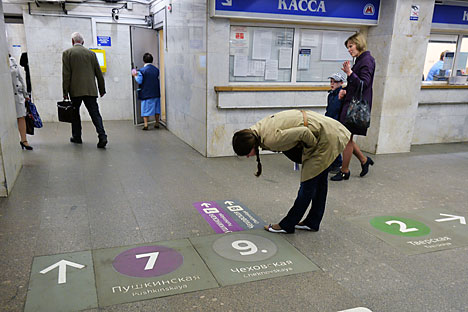
A new floor sign system at the Moscow metro's Pushkinskaya station. Source: Vladimir Pesnya / RIA Novosti
For many years now, Moscow has lagged behind St. Petersburg when it comes to making life easy for tourists, especially where getting around the city is concerned. Whereas the northern capital installed English-language maps, signs and information points throughout its subway system in the late 2000s, the Russian capital’s metro remained a serious challenge for foreign visitors to navigate.
Recent visitors to Moscow may have noticed some signs that change is afoot, however. In many stations of the Moscow subway, signs have appeared on the floor – with large lettering in Russian and English – indicating the direction to follow in order to change lines. Previously, foreign visitors using the Moscow metro had to rely solely upon deciphering the Russian-language signs hanging from the ceilings.
Student volunteers help tourists find their way in Moscow
However, this new solution has a significant drawback. “The floor navigation is visible only to a small stream of people – fewer than three people per meter. During peak hours, this navigation will simply not be noticed,” said Konstantin Trofimenko, Director of the Center for Urban Transportation Studies.
One of the biggest problems for tourists in the Russian capital remains the absence of English translations of the names of subway stations in the station vestibules and on platforms. The Department of Transportation in Moscow has not commented yet as to when this problem will be solved. However, Latin transliterations of station names can already be found in the subway cars themselves.
Finding the right exit
At four of the central stations – Okhotny Ryad, Teatralnaya, Ploshchad Revolyutsii, Lubyanka and Kuznetsky Most – the city authorities have now installed colorful stands at the exits with schematic diagrams of the station’s concourse and surrounding area, which provide information about the main attractions and infrastructural facilities.
The schematic diagrams are the work of British specialists from the City ID and Billings Jackson Design firms, who have already implemented successful projects in New York and London.
According to Alexei Novichkov, expert at the Design Laboratory at the Higher School of Economics, the design of these information booths raises no objections: The color solutions, font, layout and icons are consistent with international standards.

However, the stands do have some shortcomings. “Many questions are raised about the fact that the developers of these maps did not apply orientation to the north, and have provided layouts of the surrounding areas with respect to the exits,” says Novichkov. “A system like that is used for road navigators, but most of the ‘paper’ guides and maps are oriented strictly to north. The subway map is also oriented to north, so people may become confused.”
Muscovites and foreign visitors are generally positive about these navigation elements, with most of them citing the numbered exits from the subway as the most useful feature.
The fact is that many Moscow subway stations have several exits. One of the busiest central stations of the Moscow subway in particular, Kitay-Gorod, has more than a dozen exits. Previously, these exits were differentiated from each other only with signs in Russian referring to the names of streets and places of interest to which they led – making it easy for tourists and those with poor navigation skills to get confused.
Now, when making an appointment to meet a friend, instead of struggling to find the right spot when they tell you: “I'll meet you at the exit to Solyanka Street,” you can just propose to meet under a specific exit number.
“I’ve lived in Moscow for seven years,” says Angelika, a designer from Voronezh, “but I still don’t always know where to go to find the place I need, so the new schematic diagrams will be very useful. Previously, some subway stations had maps, but not with so much detail.”
Teething problems
Foreigners, meanwhile, focus their attention on other elements. “It is good that the new information boards have QR-codes, which can be ‘read’ by smartphones,” says Florentina, a writer from Vienna. But there are also shortcomings. “The English font of the information on posters and in the captions to theaters and museums is too small – you have to come very close to see it well,” she says.
Pleasant encounters on the streets of Moscow
Florentina was also dissatisfied with the fact that such posters are not provided at all subway stations: “When I was trying to find Tsaritsyno Park (a museum and reserve in the south of Moscow) at a subway station with the same name, it turned out to be quite difficult,” she says.
“There are no maps with landmarks for other areas, such as those already in the city center. There were no clear pointers in the English language, and the passers-by I met did not speak in English, so they could not help me,” she adds.
Officials say that the navigation system is gradually being redeveloped and improved. According to Darya Chuvasheva, a press representative for the Department of Transport of Moscow, the introduction of a unified navigation system will take place in stages.
“By the end of 2014, the system will first appear on the first subway stations on the Circle Line. By the end of 2015, we plan to install the system at all major stopping points, subway stations and transport interchange hubs,” says Chuvasheva.
All rights reserved by Rossiyskaya Gazeta.
to our newsletter!
Get the week's best stories straight to your inbox
This website uses cookies. Click here to find out more.
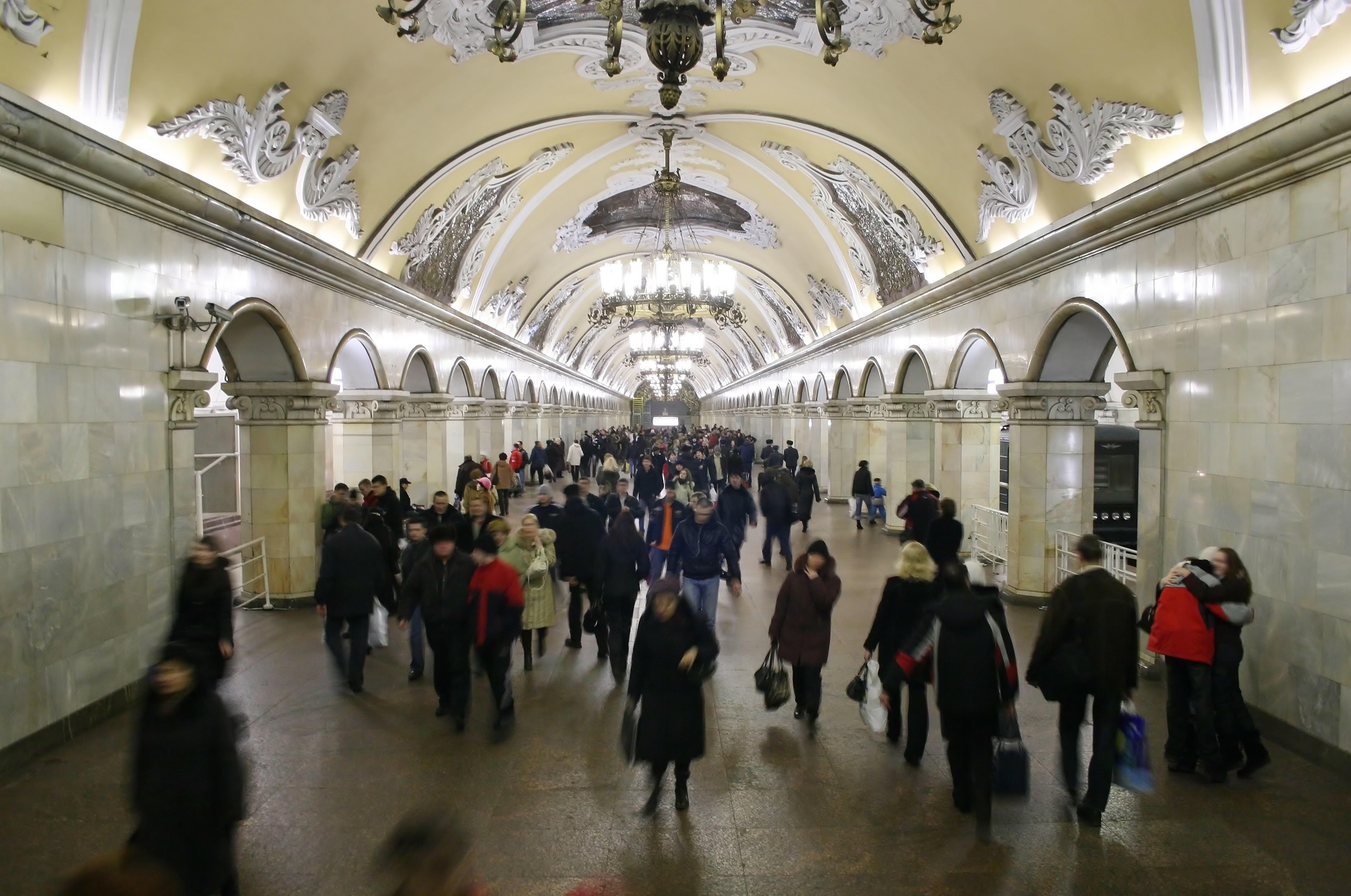
Guided Walking Tour of the Moscow Metro
Description, good to know.
- Pricing details
Departure place
You would like, admiring the frescoes in kurskaya and komsomolskaya metro stations, marvelling at the architecture of the moscow metro, listening to your guide's commentary, essential information *, duration 1 hour 50 minutes, starting time 2:00 pm.
Set off to discover the most breathtaking stops on Moscow’s beautiful metro system on this walking tour.
Some of the stops on the Moscow metro are real masterpieces. Head underground and admire the Moscow metro with your guide.
During your guided tour, you will get to admire the Ploshchad Revolyutsii , designed by the architect Dushkin. There are no fewer than 72 sculptures in this station!
You will then explore Kurskaya station, built in 1938. The design, mosaics and slogans will immerse you in the era of Stalin. You will also see the frescoes depicting Russian victories in Komsomolskaya station.
Then, continue to one of Moscow’s must-see metro stations, Novoslobodskaya , which resembles an underground palace: marble, stained glass windows...
Join your guide to explore the most lavish and important metro stops in Moscow!
- Availability: every day (excluding exceptional dates)
- Duration: 1 hr. 50 mins approx.
- Departure point: The Kremlin
- Languages: English
- Please wear comfortable shoes
- Metro tickets are included for the metro stations visited during the activity
- A valid student card will be requested from participants who have booked the reduced student tariff
- A minimum of 2 participants is required to book this activity
Price includes
- Metro tickets
- The services of an English-speaking tour guide
- The guided tour of the Moscow metro
Price doesn’t include
- Access to stations not included in the tour
- Hotel pick-up/drop-off
- Tips (optional)
- All other extras
Customers also look

IMAGES
VIDEO
COMMENTS
Arashiyama Tourism Walking Course (嵐山観光散策コース) This tour takes you around the beautiful and historic towns of Arashiyama and Sagano. Departing from Arashiyama Station of the Randen Arashiyama Line, the route heads to historical and tourist spots such as Tenryuji Temple with its Sogenchi Teien Garden (fee required), known as a historic site and special place of scenic beauty ...
Located about 7km west of downtown Kyoto, Arashiyama is one of Kyoto's most popular sightseeing districts. The heart of the district is the Arashiyama Bamboo Grove, a mesmerizing grove of thousands of tall bamboo plants. A paved walkway runs through the middle of both sections, forming the famous "Bamboo Alley," one of Kyoto's most ...
Things to Do in Arashiyama. You can visit Arashiyama Monkey Park any day of the week from 9 am until 5 pm (March 15th through September 30th), or until 4 pm (October 1st through March 14th). The entrance ticket to Arashiyama Monkey Park is 600 yen for adults and 300 yen for children ages 4 to 15.
The Arashiyama Walking Tour offers a captivating adventure through the charming district of Arashiyama in Kyoto, Japan. Led by local guides, participants can explore the iconic Bamboo Forest, where towering stalks create a serene atmosphere. They can also visit the Monkey Park, seeing the playful antics of monkeys in their natural habitat.
Arashiyama Monkey Park Iwatayama. Hours: 9 am - 4 pm. Next, you can head to Arashiyama Monkey Park Iwatayama, home to a large troop of wild Japanese macaque monkeys. Visiting this park is one of the most popular things to do in Arashiyama. Here, you can enjoy panoramic views of Kyoto while feeding the monkeys under the staff's guidance.
To sum it up, the Kyoto: 4-Hour Arashiyama Walking Tour offers a unique and immersive experience in the beautiful city of Kyoto. With a knowledgeable local guide, visitors can explore the lesser-known side of Arashiyama, visit stunning temples and shrines, and enjoy a delicious traditional lunch. With a maximum of 7 participants, this small ...
In the picturesque city of Kyoto, the 'Kyoto: 4-Hour Arashiyama Walking Tour' offers a captivating juxtaposition of hidden gems and popular attractions.. Led by a knowledgeable local guide fluent in English and Japanese, this immersive experience takes visitors off the beaten path to discover the lesser-known side of Arashiyama.
Renowned for its bamboo grove, beautiful location and famous heritage. Located in the northwestern area of Kyoto, Arashiyama draws many visitors for its world-renowned bamboo grove and beautiful scenery that changes with each season. The area is dotted with temples, old imperial villas, and famous historical sites, many of which are National ...
It was very, very green. How to get to Arashiyama: From Kyoto Station, take the JR Sagano Line (aka JR Sanin Line) to Saga-Arashiyama Station. Travel time: 15 minutes. Fare: JPY 230. From the Sagaarashiyama Station, the central Arashiyama area can be reached on foot in 5 minutes.
The Arashiyama Bamboo Grove is perhaps the most iconic spot in Arashiyama, gaining international popularity through dazzling pictures shared on social media, hinting at its bright greenery and mystery. The bamboo forest is best seen in-person, though, as it will feel like you have entered another world when you walk down the paths. It is open 24-hours.
Exiting the grove, we'll walk about ten minutes to the northern part of Arashiyama, stopping at Jojakkoji Temple. Built in the 16th century, this Buddhist temple is famous for its quiet, yet breathtaking scenery, lovely moss garden, and two hundred maple trees. Enjoying a quiet respite from the more famous sites nearby, we'll drink in the ...
Whether it's a morning or afternoon tour, the availability schedule provides flexibility for visitors to explore Arashiyama at their own pace. Duration and Additional Information. The duration of the activity is 5 hours. This 4-hour Arashiyama walking tour in Kyoto offers a comprehensive experience of the area's highlights.
Kyoto Walking Tour 2: Tofuku-ji Temple to Fushimi-Inari Taisha Shrine (4hrs) - ¥40,000. Kyoto Walking Tour 3: Classic Southern Higashiyama (4hrs) - ¥40,000. Kyoto Walking Tour 4: Gion Evening Walk (2hrs) - ¥35,000. Kyoto Walking Tour 5: Arashiyama (4hrs) - ¥40,000. Date You Wish To Do The Tour *. Time You Wish To Begin The Tour *.
Dine on sushi or kaiseki-ryori (multi-course formal Japanese dinner) to end the night. ... Check accessibility guides like Japan Accessible Tourism Center for more tips. ... Arashiyama Bamboo Grove - The walk through the bamboo grove itself takes around 15-30 minutes depending on your pace. Go as early as possible to avoid crowds.
Experience the beauty of Kyoto's Arashiyama Bamboo Forest in stunning 4K resolution! Take a virtual walking tour through this breathtaking natural wonder in ...
Cost: 550 yen. Time Spent: 1 hour. From the Monkey Park, head back across the bridge over Katsura River and find your train back to Kyoto. You will likely have a few good hours left in the day to explore some of Kyoto proper. After Arashiyama, we headed straight to Ueno Castle and then to dinner before ending our day.
The nearest airport to Elektrostal is Zhukovsky (ZIA). However, there are better options for getting to Elektrostal. There is no direct connection from Nearby airports to Elektrostal. However, you can take the train to Okruzhnaya, take the walk to Okruzhnaya, take the subway to Chkalovskaya, take the walk to Moscow Kursky Station, take the train to Fryazevo, then take the taxi to Elektrostal ...
Previously, foreign visitors using the Moscow metro had to rely solely upon deciphering the Russian-language signs hanging from the ceilings. However, this new solution has a significant drawback ...
Set off to discover the most breathtaking stops on Moscow's beautiful metro system on this walking tour. Some of the stops on the Moscow metro are real masterpieces. Head underground and admire the Moscow metro with your guide. During your guided tour, you will get to admire the Ploshchad Revolyutsii, designed by the architect Dushkin. There ...
See the best examples of underground Soviet-era architecture on a 1.5-hour walking tour of Moscow's metro stations! With an expert guide at your side, visit five of Moscow's must-see stations, including iconic Mayakovskaya, and learn all about Stalin's visions for the former Soviet Union. Hear about the Metro-2, a secret line said to have been used by the government and KGB, and see ...